William Brown Macduff.
2nd Lieutenant William Brown Macduff, 5th (Cumberland) Battalion (Territorial) Border Regiment, Born Ballingry, Fife, Enlisted Canadian Expeditionary Force, Calgary, Alberta, Canada, Residence Lochgelly, Fife, Grave reference Panel 85 to 86 Tyne Cot Memorial, West Vlaanderen, Belgium.
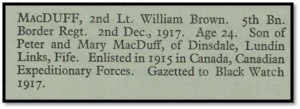

CWGC
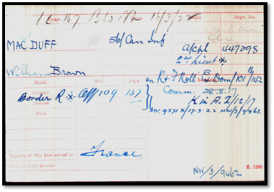
2nd Lieutenant William Brown Macduff would have been awarded the British and Victory medals, his family would have received the scroll and dead mans penny from King George v.

William Brown Macduff was born 15th June 1893, Dinsdale, Lundin Links, Fife, son of Peter Macduff occupation School Master, and Mary Macduff.
Taken from Scotland’s War site.


Second Lieutenant William Brown MacDuff, the Black Watch (Royal Highlanders attached to 11th Battalion, Border Regiment, born on 15 June 1893, was the second son of Peter MacDuff, a Headmaster, and Mary MacDuff, of Dinsdale, Lundin Links, Fife.
His siblings were Elizabeth, Donald, Margaret and Mary.
William was employed as a bank clerk. Canadian banks appear to have actively recruited from Scotland and William responded by emigrating.
He enlisted at Calgary on 18 June 1915, three days after his 22nd birthday, arriving in England in 1916, where he was attached to the Pay Office. He applied for a commission in the British Army, and embarked on officer training in May 1917. After his officer training he was commissioned to the 5th Battalion, Border Regiment. However, despite being commissioned to the Black Watch on 28 August 1917, he was attached to the 11th Battalion, Border Regiment (The Lonsdale’s).
He was killed in action on 2 December 1917, age 24, and is commemorated on the Tyne Cot Memorial.
William’s battalion had been part of an attack to consolidate the position north of Passchendaele and capture the remaining high ground on the ridge. The attack had been made on a moonlit night; trying to achieve the element of surprise, the troops advanced without any artillery support. However soon after the attack started the German machine guns opened fire causing many casualties – possibly including William. Although the Battalion succeeded in reaching their objective, they suffered high losses, including most of their officers, and were driven back by German counter-attacks. The area was a morass of mud and shell holes.
This had actually been a fairly significant action, involving ten battalions from two divisions. The whole attack had failed, and over 1,600 casualties were suffered by the British. However, despite these losses, the attack seems to have been written out of the official history of the war.
About 100 men from the battalion died during that attack, yet only 14 have a known grave.
Dunfermline Press 15th December 1917.
Second Lieutenant William B Macduff, Border Regiment is reported killed in action. He was the son of Lieutenant Colonel P Macduff, and headmaster at Lochgelly Public School. Lieutenant Macduff after serving in the Commercial Bank, Lochgelly, received an appointment in the Canadian Bank of Commerce.
UK Registers of Soldiers Effects.
2nd Lieut W.B. McDuff, 5th Border Regiment, his wife Mary would receive £63/13/6 on 2nd Feb 1918.


Probate Entry.
![]()
![]()
Family Headstone Ballingry Cemetery, Fife.
In loving memory of Peter Macduff, M.A. who died 20th October,1930 aged 72 years, for 31 years Headmaster of Lochgelly Public School, Lt Col. 7th Bn. The Black Watch, R.H.; his son Sec. Lt. William Brown Macduff, The Border Regiment, killed in action at Ypres 2nd December 1917 aged 24 years; also, his wife Mary Stewart Ma died 5th December 1938 aged 77 years; also, his daughter Elizabeth Stewart MacDuff, M.A. d. at Dinsdale, Lundin Links died 4th October 1948 aged 59 years; and his daughter Margaret Robertson Stewart 1895 – 1983.
Father Peter MacDuff.
Lieutenant Colonel Peter MacDuff, Black Watch (Royal Highlanders), born in Little Dunkeld, Perthshire in 1859, was the son of Donald MacDuff, a Farmer, and Margaret MacDuff, of Tomnagairn, Little Dunkeld, Perthshire. His siblings were John, Ann, Catherine, James and Mary.
After moving with his wife, Mary, to Lochgelly in Fife to take up the position of Headmaster at a local school in 1889 and living in West School House, he was commissioned as a Second Lieutenant in the 6th (Fifeshire) Volunteer Battalion, the Black Watch (Royal Highlanders). The battalion was also known as the ‘Lochgelly Company’. By 1903 he was a Captain, and by the time of the Territorial Act of 1907 he was in command of the company with the rank of Honorary Major.
In 1910 he was awarded the Territorial Decoration for 20 years Territorial service. The photo of him in uniform probably dates from around this time, as a medal ribbon can be seen on his left chest and he is wearing the rank insignia of a Major. The ‘T’ Territorial insignia can also be seen on his collar.
When war broke out Peter MacDuff was 56. Despite his age, in May 1915 he was sent to France with the 1st/7th (Fife) Battalion, The Black Watch, part of 2nd Highland Brigade in the Highland Division. A few days after arriving, they became part of 153rd Brigade in the 51st (Highland) Division.
After initially being sent to the Ypres salient the battalion also spent time around Aveluy and Anchonvillers on the Somme, but on 9 November 1915 Peter was invalided home.
In January 1916 he was gazetted as a temporary Lieutenant Colonel. His obituary in the Dundee Courier states that he was then sent back to France in command of a pioneer battalion, before later being put in charge of the 3rd/7th Reserve Battalion of the Black Watch in Ripon, Yorkshire. The obituary goes on to say that when this battalion was merged with others in September 1916, he returned home. However, an article in another paper states that he was called up again in August 1917, finally returning home in February 1919. His retirement was announced in the London Gazette in March 1919.
In 1924 Lieutenant Colonel MacDuff led the ex-servicemen at the unveiling of the Lochgelly war memorial, on which his son William’s name in inscribed. His wife, William’s mother, laid the first wreath on the memorial. In the newsreel footage of the unveiling, Peter MacDuff can clearly be seen towards the right of the screen. His son’s name would have been read out along with the other 268 casualties, many of whom would no doubt have been known to him as pupils at the local school during his time as Headmaster.
Peter MacDuff died in 1930, and his funeral was attended by many former members of the Fife Territorial Battalion. He is buried in Ballingry Cemetery, Fife.
Alexander Mathewson
Able Seaman Alexander Mathewson, Nelson Battalion, Clyde Z/2807, Nelson Battalion. Royal Naval Volunteer Reserve, Born Auchterderran, Fife, Residence Lochgelly, Missing later reported killed in action, Grave reference Pier and face 1A. Thiepval Memorial, Somme, France.


CWGC
A.B. Seaman Alexander Mathewson would have been awarded the British, and Victory medal, also the 15 Star. his family would have received the Plaque “Dead man’s Penny” and scroll from King George V. (Medal record not found)
Alexander Mathewson was born 27th October 1887 in Auchterderran, Fife son of Alexander Mathewson, occupation miner and Sophia Arnott. (case to be taken with details as record says record gives birth as 27th October 1882, not found) Sophia Matthewson nee Arnott died 1887, Auchterderran.
Record
William Alexander Mathewson Enlisted 5th January 1915, Draft for Hawke, Mediterranean Expeditionary Force 1st August 1915, Joined Hawke Battalion 20th August 1915, to 23rd October 1915. Invalided to United Kingdom 25th November 1915, Draft for Nelson Battalion British Expeditionary Force 25th September 1916, service till 4th February 1917, date of death.
Notes, Enlisted & served (signed) as Alexander Mathewson, records later amended to read true name of William Alexander Mathewson; A Coal Miner; born.27th October 1882 ; Home address: 26 Lumphinnans Rd., Lochgelly, Fife ; Next-of-Kin: Brother-in-Law, William Donaldson, 79 West End, Lochgelly, Fife. Buried 3/4 Mile NNW of Grandcourt and 6 Miles N of Albert, France.
The Royal Naval Division (RND) was a unique formation in World War 1, raised by the Admiralty to serve in their then traditional role as Infantrymen fighting “shoulder to shoulder” alongside their Army comrades in an emergency.
The RND originally consisted of three Infantry Brigades (two Naval and one Royal Marine) of twelve Battalions (eight Naval and four Royal Marine). As the war progressed, casualties and a lack of recruits forced the RND to steadily reduce their Naval personnel establishment.
Two Naval Battalions were disbanded in June 1915, the Royal Marine Brigade and two Royal Marine Battalions were disbanded in August 1915, two more Naval Battalions were disbanded in February 1918 and one Royal Marine Battalion in April 1918. At the war’s end, the Royal Naval Division’s Naval strength maintained only two Brigades of five Battalions (four Naval and one Royal Marine Battalion). The Army supplied the shortfall in Battalions and Brigades to the establishment of the Division from July 1916 onwards.
The Royal Naval Division was regarded as an elite unit, tasked with the \”hardest nuts to crack’ on the battlefield. Its personnel were inspired by great British Naval traditions, a high reputation and a personal sense of pride in their Battalion and Division.
Their reinforcements were drawn exclusively from the pool of men at their Base Depot. Those recovered from sickness or wounds went back to their original credits via the Base Depot/reinforcement camp, unlike the Army, who (except for the Guards Divisions) regularly dispersed men from one regiment to another via their Depots.
Fergagil McCahill.
Private Feragil McCahill, 16968, 8th Battalion Royal Dublin Fusiliers, Born Kincaulagh, Co. Donegal, Ireland, Enlisted Hamilton, Lanarkshire, Scotland, Residence Dungloe, Co. Donegal, Killed in action 29th April 1916, Grave reference Panel 127 to 129. Loos Memorial, Pas de Calais, France.


CWGC

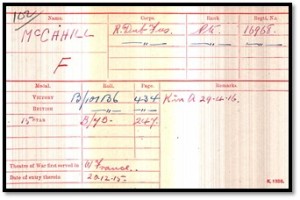
Private Feragil McCahill was awardedthe British, and Victory medal, also the 15 Star. his family would have received the Plaque “Dead man’s Penny” and scroll from King George V.
Posted to France 20th December 1915.
Feragil McCahill was born 27th March 1875, Kincaulagh, Co Donegal, Ireland, the youngest of three children born to Hugh McCahill and Sophia O’Donnell. Hugh died 1911 in Sheskinarone, Donegal, Sophia died 1912 Glenties, Donegal.
Feragil McCahill married Mary Gallagher about 1899, Ireland, they had one son Patrick who was born about 1899, Ireland. They moved to Uphall in West Lothian, Scotland, where Feragil worked as a shale miner.
In 1911, Feragil aged 34, occupation miner, was living as a boarder with the Burke family at 53 Melville Street, Lochgelly, Fife.
I believe in 1915 he was living and working in Dalmeny, Midlothian, Scotland.
UK Registers of Soldiers Effects.
Pte Feragil McCahill 8/16968, 8th Royal Dublin Fusiliers, Father Patrick received £6/13/4. on 30th Nov 1916, a further £6/0/0 received 1st Nov 1919.


Soldiers Will.
In the event of my death I leave all/any effects to my only son Patrick McCahill, Sheskinarone, Donegal, Ireland. Signed P McCahill.
Death on the Western Front Easter 1916.
While Dublin was thrown into turmoil during Easter Week 1916, the fighting in World War One rumbled on. While Irish soldiers and Irish regiments could be found across the front at the time, there was a disaster for the Irish between 27 and 29 April 1916 near the village of Hulloch in France. The area formed part of the wider area where the Battle of Loos was being fought, and by April 1916 the network of trenches in the areas was vast and the two sides separated by a few hundred yards. On one side were the Royal Bavarian Corps of the German army, and on the other I Corps of the British Army which included men from the Royal Dublin Fusiliers, Royal Inniskilling Fusiliers and the Royal Irish Fusiliers. It has been claimed that the German trenches were fronted by placards at the end of April informing the Irish battalions of the Easter Rising. One read “Irishmen! Heavy uproar in Ireland. English guns are firing on your wives and children.”
On 27 April 1916, at 5 am, German forces emptied 3,800 cylinders containing a mixture of chlorine and phosgene gas and a favourable wind blew the cloud into the British trenches. The gas attack was accompanied by a heavy artillery barrage and, later in the morning, and infantry attack on the British lines. The gas was so thick that it reduced visibility to less than three yards, and so extensive that gas masks had to be worn at over 3 miles behind the trenches. Two days later, on 29 April (the day the Rising ended in Dublin), the Germans against released gas in the Hulloch area. The wind was less favourable for the Germans on the 29th, but the gas still inflicted great damage along British lines. By the end of the 29 April all the gains that had been made by the Germans had been recaptured by allied forces. It is estimated that on the two days that gas was used at Hulloch in April 1916 over 1,260 allied troops were poisoned and 338 died. Irish regiments were particularly badly hit by the effects of the gas with the 7th Royal Irish Fusiliers having 80 casualties, the 7th Royal Inniskilling Fusiliers 263, the 8th Royal Inniskilling Fusiliers 366 and the 8th Royal Dublin Fusiliers 385. Irish casualties amounted 900 out of the 1,260 allied in total. The gas masks provided by the army at the time didn’t work properly, and in the dense cloud of gas it seems that many men could not find or fit their masks. The death from chlorine was recorded by Arthur Hurst in his Medical Diseases of War book in 1917.
Patrick McCartney
Leading Seaman Patrick McCartney, Z/2688, Howe Battalion Royal Naval Division. Royal Naval Volunteer Reserve, Born Burntisland, Fife, Enlisted Lochgelly, Residence Lochgelly, Died of wounds 9th August 1917, Grave reference 111. E.41. Aubigny Communal Cemetery Extension, Pas de Calais, France.

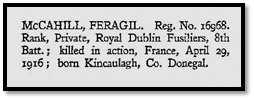
CWGC.
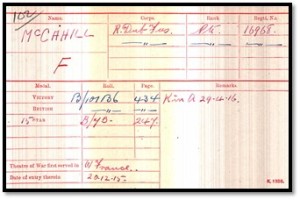
Medals passed on to widow.

Patrick McCartney was born 16th April 1887 in Burntisland, Fife, the oldest of at least 4 children born to William McCartney occupation coal miner, and Christina Milne.
On the 31st December 1910, Patrick McCartney 22, occupation miner, married Bridget Lynch 19, occupation Housekeeper, Bridget lived at 35 Broad Street, Cowdenbeath, Patrick’s address was Clarkson Cottage, Lochgelly.
In 911, Patrick McCartney 23, occupation miner, was living at 23 Church Street, Lochgelly, Bridget 20, married 1 year and bearing 1 child William 6m.
Naval Record.
Leading Seam Patrick McCartney, Z/2688, , Howe Battalion Royal Naval Division. Royal Naval Volunteer Reserve, Born 16th April 1887, Burntisland, Fife, occupation miner, Next-of-Kin & home address: Wife, 28 Church St., Lochgelly, Fife. Enlisted 21st December 1914; Draft for Mediterranean Expeditionary Force 28th June 1915, joined Howe Bn. 18th July 1915-10th August 1915 15 Piles, invalided to UK 16th September 1915; Draft for British Expeditionary Force 19th March 1917, joined Howe Bn. 11th April 1917-20th July 1917 wounded.
Died of wounds in 42nd Casualty Clearing Station (Splinter wound right buttock 9th August 1917 during Raid on enemy’s trenches)
The 63rd (Royal Naval) Division was a United Kingdom infantry division of the First World War. It was originally formed as the Royal Naval Division at the outbreak of the war, from Royal Navy and Royal Marine reservists and volunteers, who were not needed for service at sea. The division fought at Antwerp in 1914 and at Gallipoli in 1915. In 1916, following many losses among the original naval volunteers, the division was transferred to the British Army as the 63rd (Royal Naval) Division, re-using the number from the disbanded second-line 63rd (2nd Northumbrian) Division Territorial Force. As an Army formation, it fought on the Western Front for the remainder of the war.
The 42nd Casualty Clearing Station was stationed at Aubigny Feb 16 – Mar 16 and Apr 16 – Aug 18; Licheux Apr 16; Mingoval Aug 18 – Oct 18; Douai Oct 18 – Nov 19
William McCue
There was a William McQue aged 31 and was born Linlithgow, West Calder, in the 1911 census for Lochgelly. Unable to find in other records.
Alexander McDowall.
Rifleman Alexander McDowall, 40085, 7th Battalion Royal Irish Rifles, formerly 20080, Royal Dublin Fusiliers, Born Dalby, Ayrshire, Enlisted Cowdenbeath, Fife, Residence Lochgelly, Killed in action 18th January 1917, Grave reference M.46. Kemmel Chateau Military Cemetery, West-Vlaanderen, Belgium.


CWGC
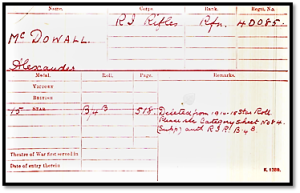
Rifleman Alexander McDowall was awarded the British, and Victory medal, also the 15 Star. his family would have received the Plaque “Dead man’s Penny” and scroll from King George V.
Seems to have been deleted from the 1914/15 Star Roll.
Alexander McDowall was born abt 1881, Ayrshire, son of James McDowall and Anne Robertson.
On 2nd June 1913 at Lochgelly, Fife, Alexander McDowall 32, occupation miner, 27 Melville Street, Lochgelly, married Agnes McQuire 35, Housekeeper, 6 Hunter Street, Lochgelly.
UK Registers of Soldiers Effects.
Pte Alexander McDowall 40085, 7th Batt Royal Irish Rifles, widow Agnes received £5/18/8. for self and children, a further £7/10/0. was received 17th Dec 1919.


When war broke out in August 1914, the Royal Irish Fusiliers comprised two regular battalions, the 1st and 2nd, and two battalions of Special Reserve, the 3rd and 4th. By the end of 1914 the Regiment had raised five service battalions: the 5th and 6th in 31st Brigade, 10th (Irish) Division; the 7th and 8th in 49th Brigade, 16th (Irish) Division and the 9th (County Armagh) in 108th Brigade, 36th (Ulster) Division. Meanwhile the 3rd (Reserve) and 4th (Extra Reserve) Battalions had been mobilised and were responsible for training new men and for holding trained soldiers, including the men of the Special Reserve, until they were required as reinforcements.
The 9th (Service) Battalion (County Armagh) was next to deploy—it landed in France in early October 1915. It was followed by the 7th and 8th Battalions in February 1916. All three fought during the Battle of the Somme and suffered grievously—the 9th at Hamel on 1 July and the 7th and 8th at Guillemont and Ginchy in September. The 1st Battalion also took part in the attack on 1 July, north of Beaumont Hamel, and it was fortunate to have been relatively uncommitted before the attack foundered and suffered fewer casualties. In October 1916 the 7th and 8th were amalgamated to form the 7th/8th (Service) Battalion.
In September 1915, the 10th (Reserve) Battalion had been formed to support the 9th Battalion. At the same time, the 1st Garrison Battalion had been raised in Dublin and in February 1916 it sailed for India, where it remained until May 1917 when it joined the Burma Division. The 2nd Garrison Battalion was raised in Dublin in March 1916 and it deployed to Salonika in August. At the end of that year the 3rd (Reserve) Garrison Battalion was raised in Dublin as the reserve battalion for the 1st and 2nd Garrison Battalions.
Donald McDowall.
Private Donald McDowall, M/39930, Royal Army Service Corps, Born Dalry, Ayrshire, Enlisted Dalry, Ayrshire, Residence Lochgelly, Died from influenza Les Baraques Military Cemetery, Sangatte, France.

CWGC
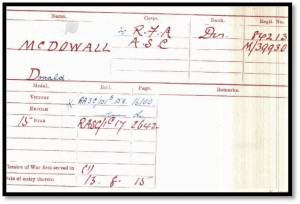
Pte Donald McDowall was awarded the Victory, British medals also the 15 Star. His family would have received the Plaque (Dead Man’s penny) and scroll from King George V.
Posted to France 13th August 1915.
Donald McDowall was born 1890, Dalry, Ayrshire, son of James McDowall and Anne Robertson.
Draft details.
Donald McDowall 23, occupation miner, joined the Royal Field Artillery 17th August 1914 at Dalry Ayrshire. Height 5 feet 4 and a half inches, 123 pounds, eyes brown, hair brown, complexion fresh. Transferred to 307th company Army Service Corps (driver) Next of Kin brother Alexander 6 Hunter Street, Lochgelly, Fife. Medals and effects sent to Miss Annie Davis 12 Park Street, Lochgelly, Fife. Brother Alexander McDowall killed in France aged 36, declaration signed by Agnes McDowall 6 Hunter Street, Lochgelly
UK Registers of Soldiers Effects.

Death Certificate.

39930, Private Donald McDowall 28, died from Bronco Pneumonia following Influenza 27th February 1919, 35th General Hospital Calais.
Andrew McEwan.
Private Andrew McEwan, S/18122, 9th (Service) Battalion Black Watch (Royal Highlanders) Born Crossgates, Fife, Enlisted Perth, Perthshire, Residence Lochgelly, Fife, Died of wounds 11th April 1917, Grave reference 111. E.34. Duisans British Cemetery, Etrun, Pas de Calais, France. Family headstone in Lochgelly Cemetery. Also commemorated on the Cowdenbeath War Memorial
https://cowdenbeathwarmemorial.wordpress.com/

CWGC.
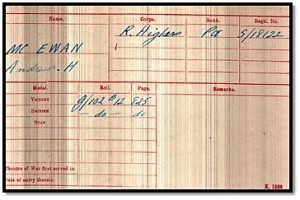
Private Andrew McEwan was awarded the British, and Victory medals, his family would have received the Plaque “Dead man’s Penny” and scroll from King George V.
Andrew Hunter McEwan was born 1889, Dunfermline, (Crossgates very near Dunfermline) the son of David Wright McEwan, occupation Stone Mason, and Elizabeth Martin. David died 1938, Cowdenbeath, Elizabeth died 1937, Cowdenbeath.
In 1911, Andrew McEwan 21, occupation Barman, was living with his family at 7 Bowling Green Street, Cowdenbeath, David 51, Mason, Elizabeth 52, married 30 years and bearing 9 children, 7 of whom survive, Janet 26, Saleswoman (Bakers) William 18, Miner, Robina 14, Shop Assistant, Walter 10, school.
On the 2nd June 1915, Andrew Hunter McEwan 25, Barman, 32 Maitland Street, Dunfermline, married Jeanie Millar 22, Shop Assistant, 31 Main Street, Lochgelly. Married at Bride’s home.
West Fife Echo 17th April 1917.
Lochgelly Losses, Private Wm(?) McEwan, Lochgelly, Black Watch, is reported killed in action. It is only about six months since he enlisted, and he has been about a month at the front.
Dunfermline Journal 21st April 1917.
Mrs Andrew McEwan, who is at present residing with her parents in Lochgelly, has been notified of the death in action of her husband Private Andrew McEwan, Black Watch, fourth son of Mr David McEwan, Bowling Green Street, Cowdenbeath, Pte McEwan who enlisted in September 1916, went to France six weeks ago. Prior to joining the colours he was employed as the manager of the Burgh Arms Inn, and was very popular throughout the district. He was an enthusiastic footballer having played for Cowdenbeath Wednesday club for a number of seasons. He leaves a widow and one son, two brothers are still in the army, Pte David McEwan, Fife and Forfar Yeomanry, and Pte Wm McEwan, RAMC.
Dunfermline Press 21st April 1917.
Information has been received by Mrs Andrew McEwan, that her husband Pte Andrew McEwan, Black Watch, son of Mr David McEwan, Bowling Terrace, Cowdenbeath, has been killed in action Pte McEwan who enlisted in September 1916, went to France six weeks ago. Prior to joining the colours he was employed as the manager of the Burgh Arms Inn. He was an enthusiastic footballer having played for Cowdenbeath Wednesday club for a number of seasons. He leaves a widow and one son, two brothers are still in the army.
UK Registers of Soldiers Effects.
Pte Andrew McEwan 18122, 9th Batt Royal Highlanders, widow Jean received £1/8/0 on 26th July 1917 for self and children, and £3/0/0. on 25th Nov 1919.
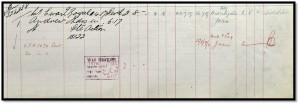
Family Headstone Lochgelly Cemetery.
In memory of my dearly beloved son David McEwan, Chief Officer, M.N. died 3rd May 1945 aged 29 years; also my dear husband Pte. Andrew McEwan, R.N. fell in action 10th April 1918 aged 28 years; also my dear mother Grace Wilson died 14 February 1926 aged 67 years; also my dear father Stewart Miller died 21 April 1948 aged 77 years; also my dear nephew Stewart killed in action at Tobruk 17th April 19__ aged __
9th Battalion, The Black Watch was raised at Perth on 13 September 1914 as part of Kitchener’s Second New Army and joined 44th Brigade, 15th (Scottish) Division. More than 50% of the original volunteers came from Lanarkshire. They trained at Aldershot, Liss, Chisledon, and commenced final training at Tidworth in May 1915. They proceeded to France landing at Boulogne on 8 July 1915.
They were in action in the Battle of Loos in 1915. In spring 1916, they were involved in the German gas attacks near Hulloch and the defence of the Kink position. They were in action during the Battles of the Somme, including the Battle of Pozieres, the Battle of Flers-Courcelette and the capture of Martinpuich, the Battle of Le Transloy and the attacks on the Butte de Warlencourt.
In 1917 they were in action in the First and Second Battle of the Scarpe, including the capture of Guemappe during the Arras Offensive.
James McGhee.
Private James McGhee/ McGee, S/4993, 9th (Service) Battalion Black Watch (Royal Highlanders) Born Larah Bailliborough, County Cavan, Enlisted Lochgelly, Fife, Residence Lochgelly, Died 27th February 1917, Grave reference Plot D Row 4 Grave 5. Calais Southern Cemetery, Pas de Calais, France.
 CWGC
CWGC
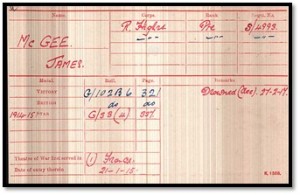
Private James McGee was awarded the British, and Victory medal, also the 1914/15 Star. his family would have received the Plaque “Dead man’s Penny” and scroll from King George V.
Posted to France 21st January 1915.
James McGee was born abt 1872 Larah Bailliborough, County Cavan.
In 1911, James McGee was living with the Clark family as a boarder at 1 Kinnard Street, Lochgelly.
UK Registers of Soldiers Effects.
Pte James McGhee 4993, drowned, brother Bernard received £7/0/0. on 24th July 1919 and £11/0/0. on 10th Dec 1919

War Diary 9th Battalion Black Watch 28th February 1917.

There is no mention of any drowning accident in the war diary of the battalion.
David McGowan.
Private David McGowan, 64845, 72nd Field Ambulance, Royal Army Medical Corps, Born Muirkirk, Ayrshire, Enlisted Lochgelly, Fife, Residence Lochgelly, Killed in action 17th June 1917, aged 26, Grave reference 111. A.43. Dichebusch New Military Extension, West-Vlaanderen, Belgium.

CWGC.
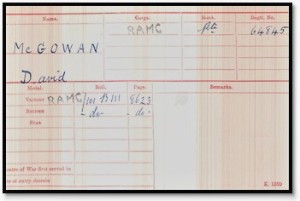
Private David McGowan was awarded the British, and Victory medals, his family would have received the Plaque “Dead man’s Penny” and scroll from King George V.
David Hogg McGowan was born 10th August 1890, Muirkirk, Ayrshire, the oldest of four children born to John McGowan occupation coal miner, and Elizabeth Elison Blyth Logie. Elizabeth died 1921, John died 1946, both Lochgelly.
In 1911, David 20, occupation miner, was living with his family at 65 Minto Cottage, Auchterderran, John McGowan 38, miner, Elizabeth 36, married 21 years and bearing 6 children 3 of whom survive, Margaret 18, Drapers Assistant, Agnes 16, Pithead worker, Martha Logie 5, (niece)
Draft Record.
David McGowan enlisted in the Royal Army Medical Corps at Lochgelly, Fife on the 22nd September 1915, Height 5ft 7ins, Weight 150 lbs, Good physical development, left eye defective, might be converted with suitable glass. Joined 25 station hospital 30th May 1917, posted to 72nd field ambulance in the field 12th June 1917. Family relatives Father John McGowan, 61 Russell Street, Lochgelly, Mother Elizabeth, same address, sisters Maggie 26, and Agnes 24, same address.
Killed in action 17th June 1917, articles returned to Mrs Elizabeth McGowan, Letters, Photos, Cards, Pocket book, Bible, Religious medalion, 4 Cap badges, 6 handkerchiefs, Shaving soap and brush, 3 razors, Watch (broken) Holdall.
Soldiers Will.
In the event of my death I leave all my property/effects to Mother Mrs Elizabeth McGowan, 61 Russell Street, Lochgelly.
Dunfermline Press 7th July 1917.
Pte D. McGowan, RAMC, 61 Russell Street, Lochgelly Killed in action 17th June.
UK Registers of Soldiers Effects.
Pte David McGowan 64845, R.A.M.C. Mother Elizabeth received £6/0/10. on 10th Sept 1917. and £7/10/0. on 27th Oct 1919.
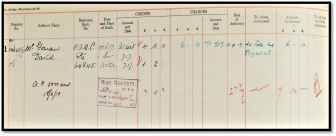
The 72nd Field Ambulance, Royal Army Medical Corps.
72nd Field Ambulance, R.A.M.C. was established in September 1914, as part of Kitchen’s New Army. They proceeded to France in August 1915, the division concentrated in the area between Etaples and St Pol on 4th September and a few days later marched across France into the reserve for the British assault at Loos, going into action on the 26th September and suffering heavy losses. In 1916 they suffered in the German gas attack at Wulverghem and then moved to the Somme seeing action at the battle of Delville Wood. In 1917 they were in action at the battle of Vimy Ridge and in June the battle of Messines.
John McKay.
Correct name John Mackay
Private John Mackay, 3294, 2nd Battalion The Royal Scots (Lothian Regiment) Born Bathgate, West Lothian, Enlisted Musselburgh, Midlothian, Residence Lochgelly, Fife, Died 9th May 1915, Grave reference 1.A.103. Longuenesse (St Omer) Souvenir Cemetery, Pas de Calais, France. (Inscription on stone “nothing in my hand I bring simply to the cross I cling, wife Jessie)

CWGC
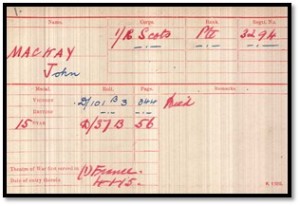
Private John Mackay was awarded the British, and Victory medal, also the 15 Star. his family would have received the Plaque “Dead man’s Penny” and scroll from King George V.
Posted to France 4th January 1915.
John Mackay was born 18th November 1871, Bathgate, West Lothian, son of James Mackay, occupation coal miner, and Jessie White, Jessie died 1902, Bathgate, James died 1883, Bathgate.
John Mackay 29, occupation coal miner, married Jessie Galloway on the 7th February 1902, Cambuslang, Lanarkshire.
In 1911, John Mackay 38, occupation miner, was living with his family at 10 Hunter Street, Lochgelly, wife, Jessie 39, married 9 years and bearing 4 children 3 of whom survive, Helen Kerr 16 (stepdaughter) John 15 miner (stepson) Adam 14 (stepson) Mary Mackay 7 daughter, Hugh 3, William 10 months
West Fife Echo 19th May 1915.
Another Lochgelly Soldiers Killed. Still another falls to be added to the list of those noble fellows who have left Lochgelly to make the supreme sacrifice in France, in the person of Sapper J Mackay number 3294, 172 Battery, Royal Engineers. His wife who resides at Hunter Street received the sad intimation on Thursday morning that he had died in the St Omar hospital on 9th May of Asphyxia gaseous poison. He enlisted at first in the Royal Scots but transferred by them to the Royal Engineers and has been in France from the early days of January. Much sympathy is felt for his widow and two young children, in being thus bereft of their husband and father, who was 42 years of age.
UK Registers of Soldiers Effects.
Pte John McKay 3294, 2nd Battalion Royal Scots, no 10 Stationary Hospital St Omer, widow Jessie received £3/10/7. on 15th Nov 1919, a further sum of £3/0/0. was received on 8th Feb 1916, for self and children.

The first use of poison gas, 22 April 1915
A bulletin issued by the French Tenth Army on 30 March 1915 noted that the German XV Corps in the neighbourhood of Zillebeke (near Ypres) had installed iron cylinders containing an asphyxiating gas into their front-line trenches. A German prisoner taken near Langemark on 14 April told of a forthcoming gas attack on the French units in that sector, arranged for noon on 13 April but delayed while waiting for a favourable wind. The man carried a small sack filled with cotton waste, which would be dipped in some chemical solution to counteract the effect of the gas. A Belgian agent reported much the same thing. A reconnaissance flight by No 6 Squadron of the Royal Flying Corps reported nothing unusual in the German positions. Further information from Belgian sources on 16 April 1915 reported the manufacture in Ghent of 20,000 face masks.
Despite these warning signs, no specific defensive steps were taken: the concept of large concentrations of a poison gas was unfamiliar, and barely believable from a practical or moral viewpoint. It was specifically banned by the Hague Convention of 1907.
The Germans attacked using a cloud of Chlorine gas, a bluish-white mist rolling forward on the wind, on 22 April 1915 near Langemarck. The subsequent fighting, with both sides rushing reinforcement into the area, developed as the Second Battle of Ypres.
Chlorine has a powerful irritant action on the lungs and mucous membranes; prolonged exposure is fatal. Men who stayed in position, especially on the firestep of the trenches, suffered least as the cloud rolled past them. Terrified men who ran with it, and the wounded lying on the ground or in trench bottoms, got the worst exposure. The Germans released 180 tonnes of gas, in a flow which lasted for 5 minutes.
James McKee.
Private James McKee, 36893, 1st Battalion Cameronian (Scottish Rifles) Formerly 30800, K.O.S.B. Born Louden Hill, Ayrshire Enlisted Perth, Perthshire, Residence Lochgelly, Fife, Killed in action 21st September 1918, Grave reference 11.C.13. Meath Cemetery. Villers-Guislain, Nord, France.
 CWGC.
CWGC.

Private James McKee was awarded the British, and Victory medals, his family would have received the Plaque “Dead man’s Penny” and scroll from King George V.
James McKee was born 1st December 1898, Louden Hill, Ayrshire, son of Robert McKee occupation Bricklayer, and Maggie McAlphine.
In 1911, James McKee 12, school, was living with his family at 112 Prospect Cottage, Lochgelly, Robert 43, Bricklayer, Margaret 40, married 17 years and bearing 5 children of whom 5 survive, Robert 16, miner, Elizabeth 14, school, Thomas 10 school, John 10m.
Dunfermline Press 12th October 1918.
L-Corp James McKee, Scottish Rifles, Prospect Cottage Lochgelly, has been killed in action, he was 20 years of age and had been 1 year at the front.
UK Registers of Soldiers Effects.
Pte James McKee 368993, 1st Batt Scots Rifles, Mother Maggie received £5/2/0. on 29th Jan 1919, a further sum of £6/0/0 was received 8th Dec 1919.

G McKenna.
No records found to date linking him to Lochgelly.
Peter McKinlay.
Private Peter McKinlay, 3/1326, 1st Battalion Black Watch, Born Glasgow, Lanarkshire, Enlisted Dunfermline, Fife, Died 13th October 1915, Grave reference 111.D.20. Dud Corner Cemetery, Loos, Pas de Calais, France.
 CWGC.
CWGC.
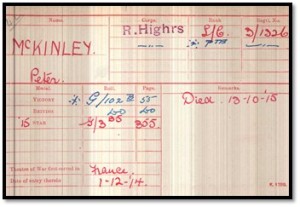
Private Peter McKinley was awarded the British, and Victory medal, also the 15 Star. his family would have received the Plaque “Dead man’s Penny” and scroll from King George V.
Posted to France 1st December 1914.
No records e.g. Birth/marriage/census/valuation rolls/newspaper, have been found for Peter McKinlay/McKinley with a connection to Lochgelly.
UK Registers of Soldiers Effects.
Pte Peter McKinley 3/1326, 1st Batt Royal Highlanders, widow Catherine received £10/4/9. for self and children on 1st Feb 1917, and £4/10/0 on 24th Oct 1919.

War Diary 1st Battalion Black Watch 14th October 1915.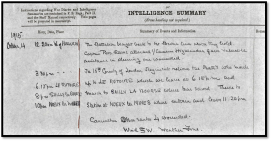
The Battle of Loos was fought from 25 September until about 16 October 1915 in an area of coalmines and mining villages near the town of Lens, north of Arras. Six British divisions attacked strong German defences in support of French offensives to the south.
The attackers suffered very high casualties in capturing the village of Loos, Hill 70 and the formidable Hohenzollern Redoubt, including some self-inflicted losses from the use of chlorine gas against the Germans. Worse came as British units tried to repel German counter-attacks. Despite initial successes and hopes of a breakthrough, the British lost the ground they had gained. By the time the battle ended British losses in men killed, wounded or missing amounted to over 60,000.
Half of the 72 battalions in the assault on 25 September belonged to Scottish regiments. Twelve Regular, Territorial and New Army Scottish battalions formed part of the 1st, 2nd and 7th Regular Army divisions. Twenty-four other battalions, consisting of volunteers, formed the 9th and 15th Scottish divisions in Kitchener’s New Army.
As a consequence, the heavy casualties in the battle affected communities throughout Scotland from which men had joined in large numbers. Dundee, for example, mourned men of the 1/4th Black Watch, a Territorial battalion mostly consisting of Dundonians, which lost 230 men killed or wounded out of 420. Another Black Watch battalion, the 9th, was one of eight Scottish battalions (out of twelve British battalions) that suffered the high level of more than 500 casualties. In its case, the heavy losses of this volunteer battalion were felt by families not only in Angus but in parts of Fife, Perthshire, Aberdeenshire, Stirlingshire, Lanarkshire and Ayrshire.
Archibald McKinlay.
Private Archibald McKinlay, 19166, 1st Battalion King’s Own Scottish Borders, Formerly 18711, Scottish Rifles, Born Lochgelly, Fife, Enlisted Cowdenbeath, Residence Lochgelly, Died of Wounds 23rd July 1917, Grave reference 1. F.20. Dozinghem Military Cemetery, West-Vlaanderen, Belgium.

CWGC.

Private Archibald McKinlay was awarded the British, and Victory medal, also the 15 Star. his family would have received the Plaque “Dead man’s Penny” and scroll from King George V.
There are 3 Archibald McKinlay’s born in Fife between 1899 and 1900, one in Auchterderran, one in Auchtermuchty, and one in Lochgelly. Several family trees are getting these three people mixed up, to the best of my knowledge and research I believe I have the correct details. I am concentrating on the Archibald McKinlay who lived at 1 Union Street, Lochgelly, as this is the address given on his soldiers will.
Archibald McKinlay was born 1896, Lochgelly, Fife, son of Archibald McKinlay occupation miner, and Elizabeth Hodge, Elizabeth died in 1922, Union Street, and Archibald died in 1923, Union Street, Lochgelly.
In 1911, Archibald McKinlay 15, occupation coal miner was living with his family at 1 Union Street, Lochgelly, Father Archibald 44, occupation miner, Mother Eliza 44, married 22 years bearing 11 children all of whom survive, Hannah 20, pithead worker, Lizzie 18, Maggie 17, pithead worker, Alexander 13, school, George 12, school, James 10, school, Robert 8, school, William 6, school, Jeanie 5.
West Fife Echo 8th August 1917.
Private Archibald McKinlay, KOSB, Lochgelly, killed, he took part in the fighting at the Dardanelles, and was stationed in Egypt for a time. He was a well known footballer, and was awarded a badge in a football competition st Suez.
UK Registers of Soldiers Effects.
Archibald McKinley, 1st Battalion KOSB, Pte 19166. 23-7-17. France, of wounds, 12-8-1918 Sole Legal Elizabeth, £9. 14/9. 7-11-19, £13. 10.
Soldiers Will.
In the event of my death I leave all my property/effects to my Mother Mrs Elizabeth McKinlay 1 Union Street, Lochgelly, signed Archibald McKinlay, 1st Battalion KOSB.
At the outbreak of war in August 1914, the two Regular Battalions and the two Territorial Battalions (4th and 5th) were mobilised. In addition, ‘New Army’ Battalions (6th, 7th and 8th) were raised, together with a 9th Battalion, which provided reinforcements for the other Battalions, and a 10th (Garrison) Battalion.
The 1st Battalion fought on the Gallipoli Peninsula and their story is typical of that ill-fated campaign. Having been severely mauled in the initial assault, they took part in the Suvla bay assault on 21 August. On 8 January 1916 the battalion was eventually withdrawn from the Dardanelles. The casualty calculations come out at the horrendous total of 100 percent. For every two months of the eight the battalion had passed at Gallipoli.
In April 1916 the battalion was moved to Beaumont-Hamel on the Somme. Here they fought in support of the Inniskilling on 1st July. In December they fought on the Ancre and April 1917 in the battle of Arras at Monchy. In August of that year they won two VCs in the battle of Langemarck. In November they fought at the battle of Cambrai and in the new year in the bloodbath of Passchendaele. In October the battalion marched into Ypres.
War Diary 1st Battalion KOSB 23rd July 1917.
23rd July, Battalion working under R.E. 1 wounded.
James McLachlan.
James McLauchlan was the only soldier found who was in the Gordon Highlanders and with a link to Lochgelly, so some care should be taken.
Private James McLauchlan, S/3285, 2nd Battalion Gordon Highlanders, Born Ochiltree, Ayrshire, Enlisted Lochgelly, Fife, Killed in action 28th April 1916, Grave reference V.E.8. Citadel New Military Cemetery Fricourt, Somme, France.
 CWGC
CWGC
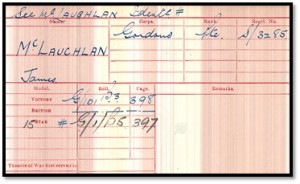
Private James McLauchlan was awarded the British, and Victory medal, also the 15 Star. his family would have received the Plaque “Dead man’s Penny” and scroll from King George V.
UK Registers of Soldiers Effects.
James McLauchlan, S/3285, 2nd Gordon Highlanders, Pte, killed in action 28-4-16. Sole legal Mrs Maggie Laughl (illegible) £3. 15. 6. 11/5/1920, £7. 0.0.
William McLaren
Private William Harley McLaren, 1673, 7th (Fife) Battalion (Territorial) Black Watch (Royal Highlanders) Born Markinch, Fife, Enlisted Markinch, Residence Lochgelly, Fife, Died of wounds 29th July 1916, Grave reference 11. E.43. Heilly Station Cemetery, Mericourt-L’abbe, Somme, France.
 CWGC
CWGC
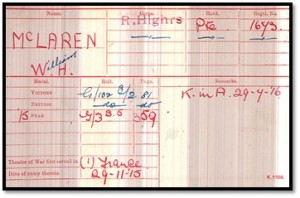
Private W.H. McLaren was awarded the British, and Victory medal, also the 15 Star. his family would have received the Plaque “Dead man’s Penny” and scroll from King George V.
Posted to France 29th November 1915.
William Harley McLaren was born 18th February 1891, Markinch, Fife, the second of five children born to Robert McLaren occupation miner, and Margaret Harley. Margaret died in 1937, Lochgelly, William died 1920, Dunfermline.
In 1911, William 20, occupation miner, was living with his family in Markinch, Robert 42, miner, Margaret 47, married 23 years and bearing 5 children of which 5 survive, Maggie 22, mill worker, Mary 15, domestic servant, Alex 8, school.
On the 27th June 1913, William Harley McLaren 22, occupation miner, address Milton of Balgonie, married Annie Grogan Bennett 22, occupation Paper worker, address Markinch.
Dunfermline Press 12th August 1916.
Mrs McLaren, Park Street, Lochgelly, has received a letter informing her of the death of her husband in France. He was in the Black Watch, and was killed on the 30th July, and is described as a popular and most obliging soldier.
West Fife Echo 16th August 1916.
Lochgelly Soldiers Fall, Mrs McLaren 60 Park Street, Lochgelly, has been notified of the death of her husband Private W.H. McLaren, Black Watch. Death occurred from wounds received on 20th July.
UK Registers of Soldiers Effects.
Pte William Harley McLaren 1673, 7th Royal Highlanders, widow Mrs Annie G Bennett received £3/12/8. on 7th Dec 1916, and £3/0/0. on 31st Aug 1921.
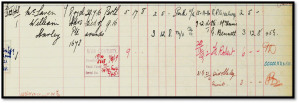
War Diary 7th Battalion Black Watch.
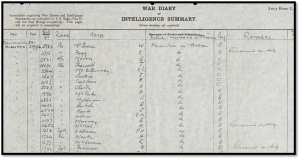
This short extract on the attack on High wood is taken from “The Fifty First in France” by Captain Robert R Ross, Gordon Highlanders, published in 1918 and republished by The Naval & Military Press Ltd.
On the 28th July 1916, the 153rd Brigade relieved the 154th Brigade in the line. It was known that an attack on High Wood was impending. The favourable opportunity was awaited with ill-concealed impatience. The exploitation of a successful push demands the most exacting preparation, the essential requirement being a precise co-operation between infantry and artillery; otherwise our brave battalions become, to use an expressive German phrase, “Kanonenfutter.” Very detailed information, secured by the resourcefulness of patrols, the intelligent interrogation of prisoners, and the daring reconnaissance of airplanes, are the only means whereby suitability of target can be guaranteed to the guns. Events proved that in the subsequent assaults on High Wood too little was known regarding its state of defence. For however intense the shelling, it was not yet intense enough to break down the resistance of the defending garrison. Although it was now common knowledge that the 51st Division would launch an offensive in conjunction with the 19th Division on the left and the 5th Division on the right, the actual zero-time was not positively fixed; or, if it was, secrecy was well maintained. It was stated that fifty deserters to the 5th Division reported preparations for a German counter-attack on their lost positions before Longeval. This attack materialized, but failed to achieve success.
On the 29th more and more fire was concentrated on the enemy. Tons of metal were hurled into High Wood and the hurriedly designed switch-line running from it to Flers. Its trees were uprooted and its timbers twisted and split and slivered. But a wood must be utterly devastated if an attack upon it is to make any progress. Merely swept down, it becomes a man-trap. Here the Germans, wonderfully tenacious of ground, wired the fallen branches, made obstacles of tree trunks, and established well posted machine guns in the corner of the wood. It was such a formidable objective that faced the brigade on the 30th, when the final orders were issued. During the afternoon an intensive bombardment prepared the way for the assaulting units. At times it increased to a drum-fire. The preliminary bombardment began at 4.45 and continued till 6.15. The brigade took up position as follows: The 7th Black Watch were opposite High Wood. On their right extended the 6th Black Watch Still farther to the right lay the 5th Gordons. The 7th Gordons were in support near the Crucifix. At Mametz Wood the 152nd Brigade lay in readiness for any emergency as divisional supports. The 154th Brigade were withheld as divisional reserve at Becordel. The 19th Division, it will be remembered, were co-operating on our left and the 5th Division on our right.
he hour of zero was 6.15. At that moment the guns lifted, and the assaulting waves leapt over the parapet. They were instantly met by a well-sustained fire from trenches that seemed to be amply manned and plentifully munitioned. From the very beginning the attack was doomed to frustration. By those awful sheets of cross-fire men were mown down in swathes. The 7th Black Watch, embarrassed by the treacherous pitfalls and blocked by a thick reseau of barbed wire, were shot down in great numbers. By 7.30 p.m. the situation was dangerous. Everywhere the assault had broken down. A précis of the reports received an hour after the initiation of the attack established the fact that the 7th Black Watch had sustained severe losses. Among the officers Captains Boase and Gillespie were known to be dead. To balance this loss a slight forward thrust had been made, but the enemy’s trenches were nowhere penetrated. Digging operations had to be resorted to. The other two battalions, similarly affected and with proportionate losses, were forced to earth. They could neither advance nor withdraw, and their casualties were mounting up at an alarming rate. Urgent appeals were therefore made to the 7th Gordons for assistance. Platoon by platoon these reinforced the firing line till all but three were absorbed. They had to pass through terrific bursts of curtain fire, but by a singular good fortune escaped without heavy losses. At 9.45 the attack on the left was resumed, and both artilleries blazed into a new access of fury. The divisions on either flank had achieved moderate successes. All night long the enemy poured destructive fire on our positions. It was deemed advisable that the 7th Black Watch should be replaced by the 7th Gordons. Instructions, therefore, were issued to that effect, and the relief was completed by 4 p.m. on the 31st without incident.
William McLaren.
Private William Harley McLaren, 1673, 7th (Fife) Battalion (Territorial) Black Watch (Royal Highlanders) Born Markinch, Fife, Enlisted Markinch, Residence Lochgelly, Fife, Died of wounds 29th July 1916, Grave reference 11. E.43. Heilly Station Cemetery, Mericourt-L’abbe, Somme, France.
 CWGC
CWGC
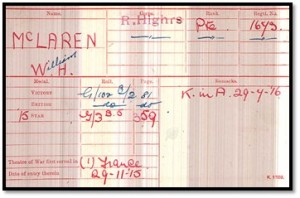
Private W.H. McLaren was awarded the British, and Victory medal, also the 15 Star. his family would have received the Plaque “Dead man’s Penny” and scroll from King George V.
Posted to France 29th November 1915.
William Harley McLaren was born 18th February 1891, Markinch, Fife, the second of five children born to Robert McLaren occupation miner, and Margaret Harley. Margaret died in 1937, Lochgelly, William died 1920, Dunfermline.
In 1911, William 20, occupation miner, was living with his family in Markinch, Robert 42, miner, Margaret 47, married 23 years and bearing 5 children of which 5 survive, Maggie 22, mill worker, Mary 15, domestic servant, Alex 8, school.
On the 27th June 1913, William Harley McLaren 22, occupation miner, address Milton of Balgonie, married Annie Grogan Bennett 22, occupation Paper worker, address Markinch.
Dunfermline Press 12th August 1916.
Mrs McLaren, Park Street, Lochgelly, has received a letter informing her of the death of her husband in France. He was in the Black Watch, and was killed on the 30th July, and is described as a popular and most obliging soldier.
West Fife Echo 16th August 1916.
Lochgelly Soldiers Fall, Mrs McLaren 60 Park Street, Lochgelly, has been notified of the death of her husband Private W.H. McLaren, Black Watch. Death occurred from wounds received on 20th July.
UK Registers of Soldiers Effects.
Pte William Harley McLaren, 1673, 7th Royal Highlanders, died of wounds 29-7-16. Wife Mrs Annie Bennett £3.12.8. and £2.5. 0. On 29-12-1919 Father Robert £6.0.0. On 31-8-1921 Widow Annie £3.0.0.
War Diary 7th Battalion Black Watch.
This short extract on the attack on High wood is taken from “The Fifty First in France” by Captain Robert R Ross, Gordon Highlanders, published in 1918 and republished by The Naval & Military Press Ltd.
On the 28th July 1916, the 153rd Brigade relieved the 154th Brigade in the line. It was known that an attack on High Wood was impending. The favourable opportunity was awaited with ill-concealed impatience. The exploitation of a successful push demands the most exacting preparation, the essential requirement being a precise co-operation between infantry and artillery; otherwise our brave battalions become, to use an expressive German phrase, “Kanonenfutter.” Very detailed information, secured by the resourcefulness of patrols, the intelligent interrogation of prisoners, and the daring reconnaissance of airplanes, are the only means whereby suitability of target can be guaranteed to the guns. Events proved that in the subsequent assaults on High Wood too little was known regarding its state of defence. For however intense the shelling, it was not yet intense enough to break down the resistance of the defending garrison. Although it was now common knowledge that the 51st Division would launch an offensive in conjunction with the 19th Division on the left and the 5th Division on the right, the actual zero-time was not positively fixed; or, if it was, secrecy was well maintained. It was stated that fifty deserters to the 5th Division reported preparations for a German counter-attack on their lost positions before Longeval. This attack materialised, but failed to achieve success.
On the 29th more and more fire was concentrated on the enemy. Tons of metal were hurled into High Wood and the hurriedly designed switch-line running from it to Flers. Its trees were uprooted and its timbers twisted and split and slivered. But a wood must be utterly devastated if an attack upon it is to make any progress. Merely swept down, it becomes a man-trap. Here the Germans, wonderfully tenacious of ground, wired the fallen branches, made obstacles of tree trunks, and established well posted machine guns in the corner of the wood. It was such a formidable objective that faced the brigade on the 30th, when the final orders were issued. During the afternoon an intensive bombardment prepared the way for the assaulting units. At times it increased to a drum-fire. The preliminary bombardment began at 4.45 and continued till 6.15. The brigade took up position as follows: The 7th Black Watch were opposite High Wood. On their right extended the 6th Black Watch Still farther to the right lay the 5th Gordons. The 7th Gordons were in support near the Crucifix. At Mametz Wood the 152nd Brigade lay in readiness for any emergency as divisional supports. The 154th Brigade were withheld as divisional reserve at Becordel. The 19th Division, it will be remembered, were co-operating on our left and the 5th Division on our right.
he hour of zero was 6.15. At that moment the guns lifted, and the assaulting waves leapt over the parapet. They were instantly met by a well-sustained fire from trenches that seemed to be amply manned and plentifully munitioned. From the very beginning the attack was doomed to frustration. By those awful sheets of cross-fire men were mown down in swathes. The 7th Black Watch, embarrassed by the treacherous pitfalls and blocked by a thick reseau of barbed wire, were shot down in great numbers. By 7.30 p.m. the situation was dangerous. Everywhere the assault had broken down. A précis of the reports received an hour after the initiation of the attack established the fact that the 7th Black Watch had sustained severe losses. Among the officers Captains Boase and Gillespie were known to be dead. To balance this loss a slight forward thrust had been made, but the enemy’s trenches were nowhere penetrated. Digging operations had to be resorted to. The other two battalions, similarly affected and with proportionate losses, were forced to earth. They could neither advance nor withdraw, and their casualties were mounting up at an alarming rate. Urgent appeals were therefore made to the 7th Gordons for assistance. Platoon by platoon these reinforced the firing line till all but three were absorbed. They had to pass through terrific bursts of curtain fire, but by a singular good fortune escaped without heavy losses. At 9.45 the attack on the left was resumed, and both artilleries blazed into a new access of fury. The divisions on either flank had achieved moderate successes. All night long the enemy poured destructive fire on our positions. It was deemed advisable that the 7th Black Watch should be replaced by the 7th Gordons. Instructions, therefore, were issued to that effect, and the relief was completed by 4 p.m. on the 31st without incident.
John McLay.
Able Seaman John McLay, Clyde Z/3055, Drake Battalion Royal Naval Division, Born Lochgelly, Fife, Enlisted and Resided in Lochgelly, Died of wounds 7th January 1916, Grave reference Sp Memorial B.15. Redoubt Military Cemetery, Turkey (Including Gallipoli)
 CWGC.
CWGC.
Medal Card.
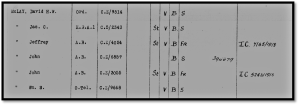
Able Seaman John McLay was awarded the British, and Victory medal, also the 15 Star. his family would have received the Plaque “Dead man’s Penny” and scroll from King George V.
John McLay was born 16th August 1890, in Auchterderran Fife, son of David McLay occupation miner, and Susan Duncan. Susan died 1946 in Lochgelly, aged 89, David died 1930 in Lochgelly, aged 73.
In 1891, John McLay aged 7 months was with his family at 17 Gardiner Street, Lochgelly.
By 1911, John McLay aged 20 occupation miner, was living with his family at 101 Butter Street, Lochgelly, David McLay 54, miner, Susan 55, married 33 years and bearing 11 children of whom 9 survive, William 32, miner, David 25, miner, Susan 22, Alex 15, miner, Nettie 10, school, Lizzie 3 (Grandaughter)
Service history.
Able Seaman John McLay, Drake Battalion, Royal Naval Volunteer Reserve, Enlisted 12th January 1915, Lochgelly, Drafted for M.E.F. 1st August 1915, joined Drake Battalion 20th August 1915. Medically unfit (Diarrhea) 20th September 1915 rejoined Drake Bn 22nd December 1915, Died of wounds 7th January 1916. Not listed in “The Cross of Sacrifice Vol.IV”; Buried in trenches at Cape Helles by Revd. B. Close. Born 16/8/1890. A Miner. Resided with father, David, at 21 Buller St., Lochgelly, Fife. Burial Redoubt Cemetery, Helles (Gi 2)
Fife Free Press 5th February 1916.
Mr David McLay, Buller Street, Lochgelly, has received intimation that his son Able Seaman John McLay, R.N.V.R. has been killed in action. He was serving with the Mediterranean expedition.
West Fife Echo 9th February 1916.
Mr David McLay, Buller Street, Lochgelly, has received official intimation that his son Able Seaman John McLay R.N.V.R. has died from wounds while in action. He was serving with the Mediterranean Expeditionary Force. A sad feature was that his parents received three letters from their son on the 27th inst, while the intimation of his death came on the 29th January. Mr McLay has other two sons and a son-in-law serving with the forces.
Dunfermline Journal 5th March 1916.
Mr David McLay, Buller Street, Lochgelly, has received official intimation that his son Able Seaman John McLay R.N.V.R. has died from wounds while in action. He was serving with the Mediterranean Expeditionary Force. A sad feature was that his parents received three letters from their son on the 27th inst, while the intimation of his death came on the 29th January. Mr McLay has other two sons and a son-in-law serving with the forces.
Gallipoli.
The division was shipped to Egypt prior to serving in the Battle of Gallipoli. Casualties before the hostilities included officer and poet, Rupert Brooke, who died at sea on 23 April 1915. The division fought on both the Anzac and Helles battlefields.
The RND was one of two British divisions (the other being the Regular Army 29th Division) at the Gallipoli landings. Originally the division was only required to make a diversion at Bulair in support of the main landings at Anzac Cove and Cape Helles. This diversion was carried out by one man, Bernard Freyberg. Shortly afterwards, on 28 April, four battalions were sent to Anzac to reinforce the hard-pressed Australian and New Zealand troops. Later the RND moved to Helles where it remained for the rest of the campaign on the peninsula.
William McLay
Private William McLay, S/21513, 1st Battalion Gordon Highlanders, Born Lochgelly, Fife, Enlisted Perth, Perthshire, Residence Lochgelly, Killed in action 23rd April 1918, Grave reference 1. A.3. Sandpits British Cemetery, Fouquereul, Pas de Calais, France.

CWGC
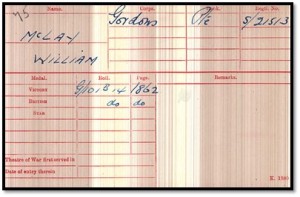
Private William McLay was awarded the British, and Victory medals, his family would have received the Plaque “Dead man’s Penny” and scroll from King George V.
William McLay was born 14th March 1899, Lochgelly, Fife, son of Alexander McLay occupation miner, and Christina Stonebanks. Alexander died 1912 in Lochgelly.
In 1911, William McLay 12, school, was living with his family at 17 Mid Street, Lochgelly, Alexander 47, miner, Christina 44, married 21 years and bearing 8 children of whom 3 survive, Eliza 16.
Dunfermline Press 18th May 1918.
Private William McLay, Gordon Highlanders, nineteen years of age , who had been only three weeks in France, is reported to have been killed in action.
UK Registers of Soldiers Effects.
Pte William McLay 21513, 1st Batt London Highlanders, Mother Christina received £3/8/10. on 20th Aug 1918, and £3/0/0. on 26th April 1919.

War diary for 23rd April 1918 states In support Vendin Les Bethune, “Quiet day relieved by 1st Battalion Royal Fusiliers, Battalion moved to billets.
David McLean
Able Seaman David McLean, Clyde Z/3065, Anson Bn. Royal Naval Volunteer Reserve, Born Lochgelly, Fife, Fife, Enlisted Lochgelly, Residence Lochgelly, Died of wounds 21st July 1915, Grave reference F.100. Lancashire Landing Cemetery, Turkey, (Including Gallipoli)
 CWGC
CWGC
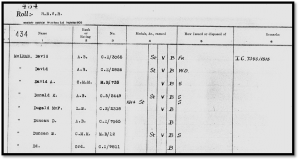
AB David McLean was awarded the British, and Victory medal, also the 15 Star. his family would have received the Plaque “Dead man’s Penny” and scroll from King George V.
David McLean was born 21st January 1896, Lochgelly, Fife, son of James McLean occupation miner, and Marjory Gray. Marjory died 1935, Lochgelly, aged 68, Alexander died 1943, aged 76.
In 1911, David 15, occupation miner, was living with his family at 25 Kennard Street, Lochgelly, James 44, occupation miner, Marjory 44, married 22 years and bearing 11 children of whom 7 survive, James 18, miner, George 17, school, John 12, school, Alex 10, school, Thomas 7, school.
Service details,
David McLean, Born 19/1/1896. A Miner. Next of kin & home address: Father, James McLean, 104 Auchterderran Rd., Lochgelly, Fife. Naval number Z/3065, Enlisted in the Royal Naval Volunteer Reserve 21st January 1915, drafted for Mediterranean Expeditionary Force 28th June 1915, joined 3rd Platoon Anson 18th July 1915, died of wounds (Gunshot wound to abdomen) 21st July 1915.
West Fife Echo 18th August 1915.
More Lochgelly Lads Killed. The toll of life among Lochgelly soldiers has been distressingly heavy since the start of the war. Able Seaman David McLean, Royal Naval Division, 103 Auchterderran Road, who has died from wounds received in the Dardanelles. He was unmarried, and was employed as a miner before enlisting.
Fife Free Press 14th August 1915.
The toll of life among Lochgelly soldiers has been distressingly heavy since the start of the war. Able Seaman David McLean, Royal Naval Division, 103 Auchterderran Road, who has died from wounds received in the Dardanelles. He was unmarried, and was employed as a miner before enlisting.
Royal Naval Division
On 16 August, Winston Churchill the First Lord of the Admiralty, decided to embody two more naval brigades with surplus men of the Naval Reserve, to join with the Marine Brigade to produce a composite Royal Naval Division. A few petty officers and ratings were transferred from the navy to provide a cadre and some officers were provided by the army but most of the recruits were reservists or men who had volunteered on the outbreak of war. The eight battalions were named after naval commanders, Drake, Benbow, Hawke, Collingwood, Nelson, Howe, Hood and Anson, later being numbered from 1st to 8th.
3rd Platoon Anson. Dardanelles.

Anson Battalion, Dardanelles.
The original plan was for a rapid advance up the peninsular and onto Constantinople, but instead the disastrous and bloody landings set the tone for what was to come. The Anson Battalion regrouped to participate in more failed assaults and skirmishes in the following weeks and months. In between they suffered from the unbearable heat, lice, dysentery (“the Gallipoli trots”) and an endless plague of flies. The insects were fat from feeding on the corpses lying unburied on the battlefield and they covered everything in sight, including the food the soldiers ate. But Jack survived all of this too.
In early June the Anson Battalion was pulled back into a rest camp at Seddulbahir, near the fort which stands at the tip of the peninsula, where the depleted force was re-organised and they took stock of kit and stores. Jack’s peacetime occupation meant that he had been allocated a role in the transport section. He was assigned the job of unloading stores and water from W and X beaches and transporting them to the camp using wagons and mules. Whilst he toiled, plans were drawn up to take the battalion off the peninsula for further rest and recuperation on the nearby island of Imbros.
William D McLean.
Able Seaman Higher Grade, Clyde Z/3078, Anson Battalion Royal Naval Volunteer Reserve, Born Lochgelly, Fife, Enlisted Lochgelly, Residence Lochgelly, Died of wounds 21st November 1916, Grave reference O.11.B.8. St. Sever Cemetery Extension. Rouen, Seine-Maritime, France.
 CWGC
CWGC
Able Seaman William Duncan was awarded the British, and Victory medals, also the 15 Star. his family would have received the Plaque “Dead man’s Penny” and scroll from King George V. (Medals passed to widow)

William Duncan McLean was born 3rd February 1888, Lochgelly, Fife, son of Alexander McLean occupation miner, and Janet Duncan. Janet died 1922 in Lumphinnans, Fife, aged 55. Alexander died 1925, Lumphinnans, aged 62.
In 1891 William was living with his parents and 3 siblings at 19 Gardiner Street, Lochgelly.
In 1901, He was living at 30 Russell Street, Lochgelly, with his parents and 7 siblings.
By 1911, William 23, occupation miner, was living with his family at 198 Cartmore Road, Lochgelly, family were, Alexander 47, miner, Janet 44, married 25 years and bearing 13 children of whom 12 survive, Robert 25, miner, Janet21, Alexander 20, miner, David 17, miner, John 16, miner, Elspeth 14, James 12, school, Helen 9, school, Jeanie 7, school, Andrew 5, Eliz 3.
On the 26th December 1913, at Mungall Street, Lumphinnans, William McLean 25, occupation miner, married Kate Young 20, occupation Bleach worker.
Service Details.
William McLean, enlisted 12th January 1915, Royal Naval Volunteer Reserve, naval number, Clyde Z/3078, Drafted to Mediterranean Expeditionary Force 1st August 1915, joined Anson Battalion 20th August 1915, 6th November 1915 Sprained left ankle rejoined Anson Bn. 25th February 1916, wounded 13th November 1916. Next-of-Kin & home address: Wife, 58 Mungall St., Lumphinnans, Fife. Died of wounds at 2.45am in 3rd Stationary Hospital Rouen (GSW Forehead 13/11/16) Died 21st November 1916.
The birth of the Royal Naval Division
The Royal Naval Brigades were composed from a large excess of naval personnel, like reserve stokers who could not be allocated to a ship of the mighty British navy. There were far more men than could be placed on a ship – numbers varying from 20,000 to 30,000 are quoted – at the outbreak of war, in early August 1914, when reservists, including those from the Royal Naval Volunteer Reserve, were called up.
To their great surprise, the reservists and volunteers were formed into two Royal Naval Brigades, which had to act like infantry. They might be needed during the war to conquer enemy ports, or defend naval bases outside the United Kingdom.
The eight naval battalions were called Benbow, Collingwood, Hawke and Drake in the 1st Brigade and Howe, Hood, Anson and Nelson in the 2nd Brigade.
The former battlefield along the Ancre has been incorporated in the tourist trail – the signs with poppies – along monuments and cemeteries which bear witness to the Battle of the Somme of 1916. Many battlefield tourists follow the road from the Thiepval Memorial along the Ulster Tower, across the Ancre River and the Railway direct to the Canadian Newfoundland Park. To the north of that park stands the monument to the Scottish 51st Division, near the deep cleft, known as the Y-Ravine.
In order to draw in battlefield tourists to have lunch, a sign stands at the junction for Beaucourt (on the D50 road) pointing to the Beaucourt Station restaurant with the text: ‘(63rd) R.N. Division’, the word ‘Café’ and a large anchor, the emblem of the Royal Naval Division.
The D50 road was the route, used by the Royal Naval Division during the attack on November 13th and 14th, 1916, and passes what remains to commemorate the battle along the Ancre to Beaucourt. That is not much. The Ancre British Cemetery, the former Beaucourt-Hamel railway station, the monument to the Royal Naval Division and the remnant of a German pill-box. Like much of the Somme battlefield, little leaves the impression that fierce battles raged here all those years ago.
Andrew McLean.
Private Andrew McLean, S/40575, 8th (Service) Battalion Black Watch (Royal Highlanders) Born Lochgelly, Fife, Enlisted Lochgelly, Residence Lochgelly, Killed in action 20th October 1916, Grave reference Pier and Face 10A. Thiepval Memorial, Somme, France.
 CWGC
CWGC
Private Andrew McLean was awarded the British, and Victory medals, his family would have received the Plaque “Dead man’s Penny” and scroll from King George V.
Andrew Pratt McLean was born 11th January 1890, Auchterderran, Fife, son of David McLean and Helen Pratt. David died 1893 Lochgelly, Helen then married James Thomson 1897, Beath, Fife,
In 1891, Andrew was living with his parents and seven siblings at 42 Park Street, Lochgelly.
By 1901, Andrew was living with his stepfather and Mother Helen Thomson at Rosebank Terrace, Auchterderran.
In 1911, Andrew McLean 21, miner, was living with his Stepfather and Mother at 41 South Street, Lochgelly, James Thomson 51, miner, Helen 45, married 14 years and bearing four children of whom two survive, Robert Thomson 11, school, James McLean 12, school, Robert Thomson 11, school, Lizzie Mclean 24, pithead worker, Lilias McLean 18, pithead worker, Alex McLean 22, miner.
UK Registers of Soldiers Effects.
Pte Andrew McLean S/40575, 8th Royal Highlanders, Sister Helen Thomson received £2/8/3. for distribution, and £8/10/0. on 10th Oct 1919.
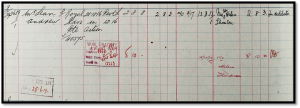
On the Western Front, 1916 was dominated by the Battle of the Somme. Five battalions of the Regiment were involved with particularly fierce actions at Contalmaison, High Wood, Delville Wood and Longeval – the last named changing frequently as the Germans counter-attacked and further assaults were made to regain it. Eventually it was held but by then the 8th Battalion was reduced to just 171 men. The year ended with the extremely hard fought battle at Beaumont-Hamel with the 6th and 7th Battalions particularly distinguishing themselves.
Thomas Mclean.
Private Thomas McLean, T2/018149, Army Service Corps, Born Auchterderran, Fife, Enlisted Lochgelly, Residence Lochgelly, Died 26th September 1918, Grave reference R.99D. Lochgelly Cemetery, Fife.
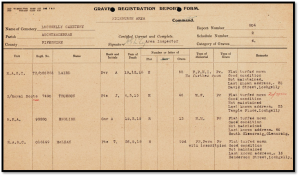
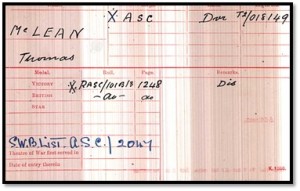
Driver Thomas McLean was awarded the British and Victory medals his family would have received the Plaque “Dead man’s Penny” and scroll from King George V.
SWB, Silver War Badge list. ASC/2047.
Thomas McLean was born 1st August 1887, Auchterderran, Fife, son of Alexander McLean occupation miner, and Mary Adamson, Mary died 1925, Lochgelly, Alexander died 1925 Lochgelly.
Thomas McLean 20, occupation miner, married Helen Jardine 19, 20th August 1907, Auchterderran, Fife.
By 1911, Thomas 23, occupation coal miner/hewer, was living at 49 Grainger Street, Lochgelly, with his wife and child, Helen 22, married 3 years and bearing 1 child, which survives, Elizabeth 2.
Pension Record.
No T2/018149, Thomas McLean, 27years 2m, Auxiliary Service Corps (Driver) Auchterderran, Fife, Enlistment date 15th October 1915, occupation miner, Home 15th Oct 1914 to 4th March 1916, France 5th March 1916 to 25th Oct 1917, Home 26th Oct 1917 to 11th January 1918. Next of kin Mrs Thomas McLean (wife) 7 Henderson Street, Lochgelly. Marriage Ellen Jardine (spinster) marriage date 20th August 1907, Lochgelly, daughter, Elizabeth Dobson McLean born 4th March 1909, Lochgelly.
Height 5ft 5ins, Weight 139lbs, Chest 38ins, Hair Black, Eyes Brown, Fresh Complexion, Discharged 11th January 1918, Cause of discharge Physically unfit, General paralysis of the insane. Date and place of origin, unknown, has had syphilis, aggravated by service during present war, treatment recommended.
Death Certificate.

Thomas McLean, coal miner, Army pensioner (married to Helen Jardine) September 26th 10:50am Fife and Kinross district asylum, Usual residence 7 Henderson Street, Lochgelly. Age 31, Father Alexander McLean, coal miner, Mother Mary Adamson. Cause of death General paralysis of the insane, 1 year, witness M Brown messenger.General paralysis of the insane, 1 year.
UK Registers of Soldiers Effects.
Driver Thomas McLean 018149, R.A.S.C. widow Helen received £5/10/0. and on 16th Aug 1920 £11/0/0.

Headstone, Lochgelly Cemetery.
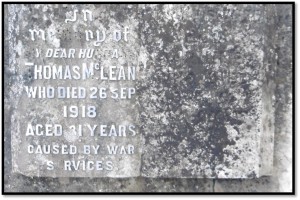
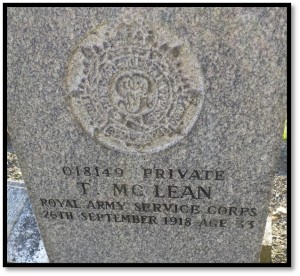
Robert McLean.
Private Robert McLean, 43044, Royal Army Medical Corps, Born Lochgelly, Fife, Enlisted Lochgelly, Residence Lochgelly, Died 13th November 1919, Grave reference L.121. Bowhill Cemetery, Auchterderran, Fife.
 CWGC
CWGC
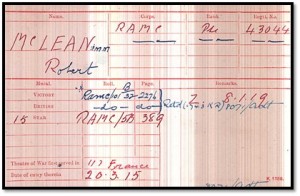
Private Robert McLean was awarded the British, and Victory medals, also the 15 Star and Military Medal, his family would have received the Plaque “Dead man’s Penny” and scroll from King George V. (Victory and British medals returned to family 8th January 1919.
Posted to France 30th March 1915.
Robert McLean was born 11th September 1892 Auchterderran, Fife, son of David McLean occupation coal miner, and Christina Erskine. Christina died 16th October 1894, 7 Hall Street, Lochgelly, aged 23. David married Betsy McDonald 1895, he died 30th November 1911, Lumphinnans, Fife. aged 38.
Robert McLean 18, occupation miner, married Janet Watson Evans 1910, Lumphinnans, Fife. Janet remarried in 1920 to Peter Robb.
In 1911, Robert McLean 18, occupation coal miner, (married) was living with his wife Janet McLean 18, occupation Mill worker, the family they were staying with at 64 Primrose, Leslie, Fife, were Alison Robertson 59, Daughter Margaret 24, Grandaughter Annie Evans 12,

Death Certificate

Robert McLean 27, coal miner, late Pte R.A.M.C. married to Janet Watson Evans, November 13th 1919, Military Hospital Craigleith Edinburgh, (usual address 13 Minto Street, Lochgelly) cause of death, Cardiac Valvular disease, three years two months. Janet McLean widow.
Headstone Bowhill Cemetery.

Andrew Mclean.
Sapper Andrew McLean, 79884, Royal Engineers, formerly 16491, Royal Scots Fusiliers, 173rd Tunneling Company, Royal Engineers, Died of wounds 30th October 1917, Grave reference V1.A.35. Mendinghem Military Cemetery, West-Vlaanderen, Belgium.

CWGC
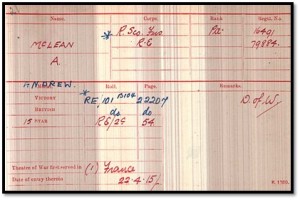
Sapper Andrew McLean was awarded the British, and Victory medal, also the 15 Star. his family would have received the Plaque “Dead man’s Penny” and scroll from King George V.
Posted to France 22nd April 1915.
Andrew Coventry Ferguson McLean was born 16th July 1896, Auchterderran, Fife, son of Alexander McLean occupation Coal miner, and Elspeth Ferguson. Elspeth died 1930, Lochgelly, Alexander died 1937, Dunfermline.
In 1911, Andrew 14, was living with his family at 6 Hunter Street, Lochgelly, Alexander 46, occupation miner, Eliz 47, married 26 years and bearing 6 children of which 3 survive, Effie 12, school, Janet 11, school.
On the 7th April 1914, Andrew McLean enlisted in the Royal Garrison Artillery, aged 18, occupation miner, previously he was with the Black Watch. He was discharged 29th May 1914, on payment of 10 pounds. Height 5ft 6ins, 125lbs, 38-inch chest, fresh complexion, grey eyes, dark brown hair.
UK Registers of Soldiers Effects.
Corp Andrew McLean 79884, R.E, 176rd Tunnelling Company, Mother Elspeth received £15/0/2. on 19th March 1918 and £13/0/0 on 19th Nov 1919.
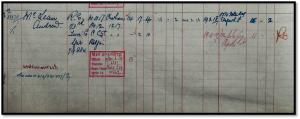
Soldiers Will
In the event of my death I leave all my property/Effects to my Mother Mrs A McLean 61 Russell Street, Lochgelly.
Memorial Details
Service No: 79884, Age: 21, Regiment/Service: Royal Engineers, 173rd Tunnelling Coy.
Son of Alexander and Elspeth McLean, of 61A, Russell St., Lochgelly, Fife. Mother was Elspeth Ferguson, b1864, d1930. Also, Andrew Coventry Ferguson McLean’s birth date/location is 6 July, 1896 in Auchterderran Parish, Lochgelly, Fife, Scotland.
The 173rd Tunneling Company.
In the spring of 1915, the newly formed 173rd Tunneling company was given the job of undertaking a major mining operation beneath hill 60. In the first British offensive underground attack operation in the Ypres salient they laid six mines by 10th April 1915, an operation planned by Major General E Bulfin, commander of the 28th Division and continued by the 5th Division when the 28th were relieved. Work beneath Hill 60 began in early March and three tunnels were begun towards the German line about 50 yards away, a pit was dug some 16-foot deep. Almost immediately the miners came upon dead bodies and quick lime had to be brought over to cover them. By the time the work was finished, the tunnels stretched 100 yards. Two mines in the north were charged with 2000 pounds of explosives each two mines in the centre had 2700 pounds charges and in the south one mine was packed with 500 pounds of gun cotton although work on it had been stopped when it ran close to a German tunnel. The explosive charges were ready on the 15th April and on the 17th April at 19:05 the mine was fired.
From January 1916 to April 1917, tunnelling company waged war underground on three levels, (Main, Deep, Deep Deep) in the hill 70 copse double crassier area of Loos, supported by the newly raised 258th tunnelling which deployed in April 1916.
In spring of 1917 173rd tunneling company moved to the Ypres Canal sector near Bosinge where it commenced work on the dugout at Yorkshire Trench. This was an addition to the existing fortification: it was a fist line trench for about one year between summer and autumn of 1916 until the summer of 1917. The completed Yorkshire trench dugout then served as headquarters for the 13th and 16th Battalions the Royal Welsh Fusiliers at the start of the Battle of Passchendaele later that year. The BEF had decided to carry out all operations in the offensive of summer 1917 from deep dugouts. East of the Ypres canal in the lose vicinity of Yorkshire trench there were several more dugouts, seven of which south and south east of Yorkshire trench were finished by the 173rd or 179th tunneling companies of these, Yorkshire trench, Butt 18, Nile Trench and Heading Lane Dugout were double Battalion Headquarters, Bridge 6 was a brigade headquarters and Lancashire Farm Dugout contained two Battalion and Two Brigade Headquarters. The condition of the ground made digging the deep dugouts extremely difficult and dangerous. Work had to be carried out silently and secretly, facing an observant enemy who was only a few hundred meters away.
Thomas McLean.
A/Sergeant Thomas McLean, 8th (Service) Battalion Black Watch (Royal Highlanders) Born Auchterderran, Fife, Enlisted Lochgelly, Residence Lochgelly, Killed in action 9th April 1917, Grave reference L.8. Ste. Catherine British Cemetery, Pas de Calais, France.
![]() CWGC
CWGC
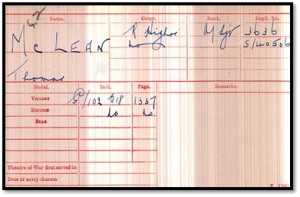
Corp Thomas McLean was awarded the British, and Victory medals, his family would have received the Plaque “Dead man’s Penny” and scroll from King George V.
Thomas McLean was born 17th June 1890, 42 Park Place, Lochgelly, Fife, son of David McLean occupation miner, and Helen Ritchie. Helen died 16th March 1936, Lochgelly, Fife, David died 28th November 1933, Lochgelly.
In 1891 Thomas 7m, was the youngest of 8 children born to David and Helen McLean, 42 Park Place.
By 1901, Thomas 10, was living with parents and 4 siblings at 20 Well Road, Lochgelly.
1911 saw Thomas 20 occupation coal miner was living with his family at 20 Well Road, Lochgelly, Father David McLean 62, occupation coal miner, Helen 59, married 37 years and bearing 9 children of which 8 survive, David 22, miner.

Thomas McLean travelled on the Letitia, arriving at St Johns, Newfoundland, Canada, 15th April 1914.
Fife Free Press 28th April 1917.
Lochgelly, Casualties, Sergt Thomas McLean, Black Watch, he came from Canada to enlist.
Dunfermline Press 5th May 1917.
Sergt Thomas McLean, Killed in action, Lochgelly.
UK Registers of Soldiers Effects.
Cpl Thomas McLean 40506, 8th Royal Highlanders, Mother Helen McLean received £7/15/6 and £12/0/0. on 27th Nov 1919.
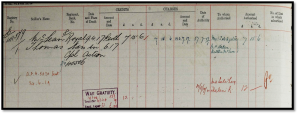
War Diary 8th Battalion Black Watch 9th April 1917.

The Battle of Arras began on 9 April 1917, preceded by a four-day bombardment, and lasted until 16 May. Its aim, as for the Somme in 1916, was to break through the German line, this time in conjunction with a major French assault, the Nivelle Offensive, 50 miles to the south. The French attack was timed to start a week after the British attack allowing the latter to, hopefully, draw German troops away from the French front.
The 8th Battalion Black Watch had worked ceaselessly at its pioneer tasks in support of 51 (Highland) Division throughout the battle of Arras. The dangers of working close to the front line were clearly demonstrated by its casualties of ten officers and 93 soldiers killed or wounded in April and May. When these are added to the losses of the other seven Royal Scots Battalions involved at Arras, the total figure amounts to over 3,100 casualties in less than four weeks.
Patrick McLuskie.
McLuskie/McLuskey.
Private Patrick McLuskey, 16527, 13th Battalion The Royal Scots (Lothian Regiment) Born Wishaw, Lanarkshire, Enlisted Cowdenbeath, Fife, Residence Lochgelly, Killed in action 11th May 1916, Grave reference Panel 10 to 13, Loos Memorial, Pas de Calais, France.
 CWGC.
CWGC.
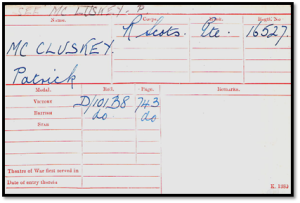
Private Patrick McCluskey the British, and Victory medals, his family would have received the Plaque “Dead man’s Penny” and scroll from King George V.
Patrick McLuskey was born 1896, Cambusnethan, Lanarkshire, son of John McLuskey occupation miner, and Elizabeth McGrieve. Elizabeth died 1919, Lochgelly.
By 1911, Patrick McLuskie 14, occupation miner, was living with his family at 28 Hunter Street, Lochgelly, John 48, miner, Elizabeth 45, married 22 years and bearing 10 children of whom 4 survive, Hugh 19, miner, Marjory 8, school, Angus 3.
UK Registers of Soldiers Effects.
Pte McLuskie 16527, 13th Royal Scots, Father John received £0/10/0. on 12th July 1917, and £6/0/0. on 24th Oct 1919.
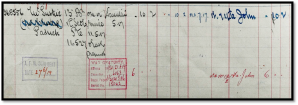
13th Battalion Royal Scots, 11 May 1916.
At 4:00 p.m. German artillery began to fire on the front of the 15th Division (Major-General F. McCracken) and at 4:25 p.m., the shelling fell on the Kink, from Border Redoubt to Clifford Street, in the area of the 13th Royal Scots of the 45th Brigade. The British artillery returned fire soon after but dust and smoke obscured the front and made observation impossible. McCracken ordered the reserve brigade to readiness, moved a battalion to Noyelles and manned machine-guns in the Village Line. At 5:00 p.m., the Germans sprung a mine near Hohenzollern Redoubt and then the German artillery-fire on the Kink diminished and increased at the redoubt. British artillery also switched targets and a German infantry attack was repulsed by the artillery and the small-arms fire of the 11th Argyll and Sutherland Highlanders (11th Argyll’s)
German artillery-fire increased at the Kink again at 5:45 p.m. and became one of the greatest concentrations of shell-fire on a small area of the war. Villages and artillery positions behind the front line were bombarded with high explosive and gas shells. The 13th Royal Scots in the first line had been killed, casualties had reduced the rest of the battalion by half and the ground had become a field of shell-holes. Battalion headquarters had been hit by a shell at 4:00 p.m., which wounded or killed everyone inside and created a command vacuum. At 6:00 p.m., German infantry moved forward, screened by the craters in no man’s land and overwhelmed the survivors in the front line, after a short exchange of fire and then occupied Anchor Trench just behind, as the surviving 30–40 Scots in the trench, retreated to Sackville Street.
Hugh McLuskie.
McLuskie/McLuskey.
Private Hugh McClnsky (Mistranscribed) 2300, 2nd Battalion Black Watch (Royal Highlanders) formerly 6025, 4th Dragoons, Born Dalziel, Lanarkshire, Enlisted Lochgelly, Fife, Residence Lochgelly, Killed in action 12th December 1914, Grave reference V11. G.1. Brown’s Road Military Cemetery Festubert, Pas de Calais, France.
 CWGC.
CWGC.
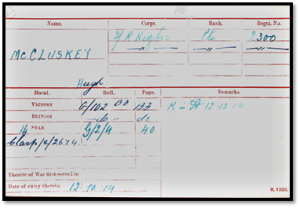
Private Hugh McLuskey was awarded the British, and Victory medal, also the 14 Star and clasp, his family would have received the Plaque “Dead man’s Penny” and scroll from King George V.
Posted to France 12th October 1914.
Hugh McLuskey/McLuskie was born 1894, Dalziel, Lanarkshire, son of John McLuskie, and Elizabeth McGrieve. Elizabeth died 1919, Lochgelly.
By 1911, Hugh 17, occupation miner, was living with his family at 28 Hunter Street, Lochgelly, family were, John 48, occupation miner, Elizabeth 45, married 22 years and bearing 10 children of whom 4 survive, Patrick 14, miner, Marjory 8, school, Angus 3.
Dundee Courier 5th January 1915.
Information has been received that Private Hugh McLuskie, Royal Scots, 28 Hunter Street, Lochgelly, was killed in action on the 12th December. Private McLuskie whose photo we reproduce was only 21 years of age, and came to France with the Indian Expeditionary Force.
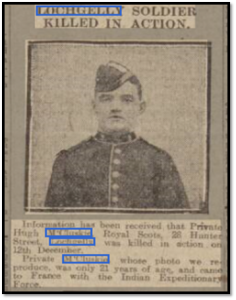
UK Registers of Soldiers Effects.
Pte Hugh McLuskey 2300, 2nd Royal Highlanders, Father John received £3/15/5. on 15th Sept 1915, Mother Elizabeth £0/15/1. on 7th June 1916, John another £5/0/0 in all 27th Feb 1920.

War Diary 12th December 1914.
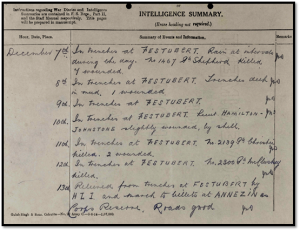
James McNeil
Corporal James McNeill, ME/228, South African Mounted Engineers, Died Roberts Heights,8th August 1917, Grave reference N.C.4170, Johannesburg (Brixton) Cemetery, Gauteng, South Africa.
 CWGC
CWGC
James McNeill would have been awarded the British, and Victory medals, his family would have received the Plaque “Dead man’s Penny” and scroll from King George V.
No link to Lochgelly has been found to date other than this article in the Dunfermline Press for 29th September 1917.
Dunfermline Press.
Lochgelly, Corp James McNeill, Lochgelly, has died in Central Africa where he was serving. He was one of five brothers engaged with the colours.
CWGC South Africa War Graves Project.
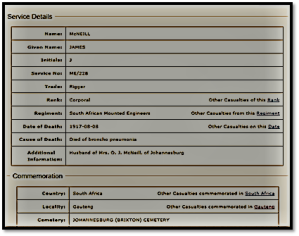
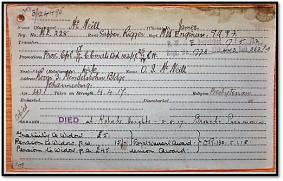
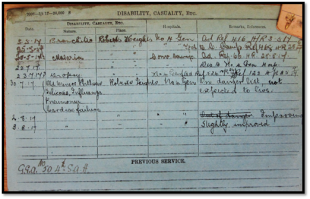
Headstone.
In loving memory of my dear husband Corporal James McNeill late of the S.A.H.& S.A.E.C.who died at Roberts Heights 8th August 1917 R.I.P.

Edward McQuade
Private Edward McQuade, S/6181, 10th Battalion Black Watch (Royal Highlanders) Born Blantyre, Lanarkshire, Enlisted Perth, Perthshire, Residence Lochgelly, Fife, Died of wounds 23rd October 1918, Grave reference 11. A.25. Vadencourt Military Cemetery, Maissemy, Aisne, France.
 CWGC.
CWGC.
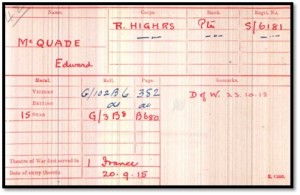
Private Edward McQuade was awarded the British, and Victory medal, also the 15 Star. his family would have received the Plaque “Dead man’s Penny” and scroll from King George V.
Posted to France 20th September 1915.
Edward McQuade was born 1893 Blantyre, Lanarkshire, the second of eleven children born to Edward McQuade occupation miner, and Annie McInally. Annie died 1954 Inverkeithing, aged 82, Edward died 1938, Inverkeithing.
In 1911, Edward 18, occupation miner was living with his family at 42 High Street, Lochgelly, Annie 40, Mary 20, James 16, Miner, David 9, George 7, John 5, William 3.
Dunfermline Press 9th November 1918.
Private Edward McQuade, Black Watch, a son of Mr and Mrs McQuade, of 12 Lansdale Street, Lochgelly, has been killed in action. He enlisted over three years ago, and saw service in Salonika before being transferred to France. He was employed as a miner.
UK Registers of Soldiers Effects.
Pte Edward McQuade S/6181, 1st Royal Highlanders, Father Edward received £26/0/6. on 22nd Feb 1919.
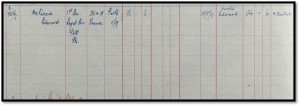
Wartime Memories Project 10th Battalion Black Watch.

James McQuade.
I thought that the James McQuade on the Lochgelly War Memorial would be the brother of Edward McQuade. The brother of Edward married Nora Plunkett in 1920 in Lochgelly, the only other possibility is a John McQuade who was in the Royal Field Artillery, but he was born in Belfast, and no link to Lochgelly has been found to date.
William W E Melville.
Private W.E. Melville, S/26754, 8th Battalion Seaforth Highlanders, Born Auchterderran, Fife, Enlisted Perth, Perthshire, Residence Lochgelly, Killed in action 15th September 1918, Grave reference 111.F.D. Philosophe British Cemetery Mazingarbe, Pas de Calais, France.

CWGC.
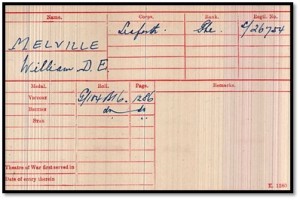
Private W Melville was awarded the British, and Victory medals, his family would have received the Plaque “Dead man’s Penny” and scroll from King George V.
Posted to France July 1915.
William Drummond Easton Melville was born 24th April 1899, Auchterderran, Fife, the oldest of eight children born to David Melville, occupation miner, and Elizabeth Easton. Elizabeth died 6th August 1963, Lochgelly, aged 83, David died 22nd September 1962, Lochgelly, aged 83.
UK Registers of Soldiers Effects.
Pte William D.E. Melville 26764, 8th Seaforth Highlanders, Mother Elizabeth received £3/13/0. on 22nd Jan 1919, a further sum of £3/0/0 was received 15th Dec 1919.

War Diary 8th Battalion Seaforth Highlanders 15th September 1918.
05:0am. The enemy placed a barrage on the outmost limits scoring with direct hits, the rest of the day was quiet, weather fine, Casualties 4 killed, 1 wounded.
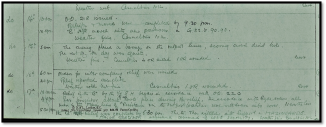
John Menzies
Lance Corporal John Menzies, 3/2941, 2nd Battalion Black Watch (Royal Highlanders) Born Dundee, Angus, Enlisted Lochgelly, Fife, Residence Lochgelly, Killed in action 21st January 1916, Grave reference Panel 25 and 63. Basra Memorial, Iraq.
 CWGC
CWGC
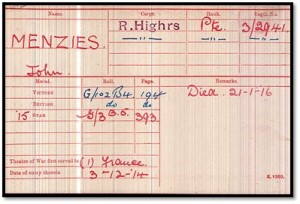
Pte John Menzies was awarded the British, and Victory medals, also the 15 Star. his family would have received the Plaque “Dead man’s Penny” and scroll from King George V.
Posted to France 3rd December 1914.
John Menzies was born 1882 in Dundee, Angus, son of William Menzies and Elizabeth Lindsay, Elizabeth died 1904, Dundee.
On the 25th July 1904, at St Mary’s R.C. church Dundee, John Menzies 22, occupation Blacksmith, married Margaret McGurk 20.
In 1911, John Menzies 29, occupation Blacksmith was living with his family at 26 Grainger Square, Lochgelly, Margaret (wife) 27, married 6 years and bearing 3 children of whom 2 survive, John 5, Maggie 2.
Dunfermline Press 11th March 1916.
Lochgelly Man Missing, Mrs Menzies received intimation that her husband Private John Menzies, Royal Highlanders, has been missing since 21st January. He served through the South African War. (same article in Fife Free Press 11th March 1916)
UK Registers of Soldiers Effects.
L/Cpl John Menzies S/2941, 2nd Royal Highlanders, widow Margaret received £6/0/0. on 1st Dec 1919.

The attack on Hanna 21st January 1916.
On this day over one hundred years ago, 75 men of The Black Watch lost their lives. Read on to discover what caused this spike in casualty numbers. As the situation for the besieged British forces at Kut grew more desperate, General Townshend eventually announced that he would have to put the defenders on half rations. This increased the sense of urgency amongst the Kut relief force. Having suffered heavy casualties at the battles of Shaikh Sa’ad on 7th January and the Wadi on 13th January, and with the Turkish defences in front of them stiffening, the possibility of being able to relieve Kut seemed more and more remote. This did not stop the soldiers of the 7th Division though and doggedly they kept going, one blistered footstep in front of another. There never seemed to be an end to the Turkish troops though, and these weary men, undersupplied and forever thirsty, performed almost superhuman feats of bravery and endurance, as they slammed themselves against Turkish defences time and time again, the thought of their fellow soldiers enduring the hell that was the siege of Kut driving them forward.
By the 20th of January the British 7th Division was beginning to resemble a shadow of the army formation that had set out just two weeks earlier. Heavy casualties, combined with sickness and the pace of the march, meant that many of its battalions were below half strength. The 2nd Battalion Black Watch seems to have suffered particularly badly, especially in numbers of wounded and killed, and could only muster some 250 effective soldiers for the battle to come. The Turkish army in front of them protecting the route to Kut, on the other hand, was well supplied and in a strong position. With the Suwaikiya Marsh on their left and the River Tigris on their right, it would have been difficult, if not impossible, to outflank their lines. As a result, the British forces would be required to storm the Turkish defences head on.
Having occupied a series of trenches in front of the Turkish lines on 19th January, the next day saw the attacking battalions, including the 2nd Black Watch, only some 200 yards from the Turkish trenches. Major Hamilton-Johnston (who two weeks before was a Captain, but owing to casualties amongst the officers of the 2nd Black Watch found himself not only an acting Major, but also commanding the battalion) wrote to the Brigade Commander stating that he was confident his men could take the first Turkish line, but due to the lack of men would need support to hold it. He therefore asked for the supporting battalions to be brought closer to the 2nd Black Watch; unfortunately, this suggestion was not carried out.
The British artillery opened up a barrage on the 20th which continued throughout the day and the following morning. Just how ineffective this barrage was, using weapons some of which dated back to 1873, is proved a few days after the attack when, during a temporary truce to clear the battlefield, a Turkish officer mentioned with contempt the power of the British artillery. At seven minutes past eight on the morning of the 21st the 2nd Black Watch surged forward from their trenches towards the Turkish lines, just as the artillery barrage lifted.
With their usual mixture of bravery and stubbornness the 2nd Battalion did manage to take the Turkish trenches to their front, despite enduring a hail of bullets as they advanced. However, the attacking troops to their right and left, the Dogras and the Buffs respectively, failed to achieve the same level of success and as a result The Black Watch found themselves isolated and exposed in their captured trench. The Turks, who had initially fled to their second line trenches in the face of The Black Watch assault, soon realised just how few troops were facing them and two counter attacks, one to the left and one to the right of the 2nd Black Watch, began to develop. These were kept at bay for a while by a small number of machine guns that had been captured from the enemy. However sheer weight of numbers soon began to tell, and gradually the defending soldiers of The Black Watch found themselves being squeezed tighter and tighter into a small part of the captured trench. It was at this point that Major Hamilton-Johnston was killed. In fact, so many officers had fallen, wounded or killed, that command of the Battalion devolved down to Second Lieutenant Henderson, who had just three month’s service with the Battalion.
For two hours the Battalion held out against almost overwhelming odds. Another who fell during this time was Sergeant Finlay, who had won a Victoria Cross on the 9th May 1915. By 10.15 am though the situation was desperate, almost surrounded and risking being destroyed, Henderson gave the command to withdraw, bringing with them one Turkish officer and around a dozen captured soldiers. The withdrawal was by no means easy and the remnants of the Battalion fought their way back to an advanced British trench some 50 yards in front of the British lines, which they then held until nightfall when they were relieved by soldiers from the 9th brigade.
Back behind the lines the exhausted Henderson handed over command of the Battalion to Second Lieutenant Stewart-Smith, the Transport Officer, who ordered the 99 surviving men of The Black Watch to rest. The next day, after the Battalion having been reinforced by the Battalion Headquarters officers and men, reported a strength of 5 officers, which included the Medical Officer and the Chaplain and 164 other ranks. This was out of a total strength of 29 officers and 900 men who had landed at Basra just three weeks before.
George Millar
Millar/Miller.
Lance Corporal George Miller, 3/3021, 1st Battalion Black Watch (Royal Highlanders) Born Haddington, East Lothian, Enlisted Kirkcaldy, Fife, Residence Lochgelly, Fife, Killed in action 28th October 1914, Grave reference Panel 31. Ypres (Menin Gate) Memorial, West Vlaanderen, Belgium.
 CWGC
CWGC
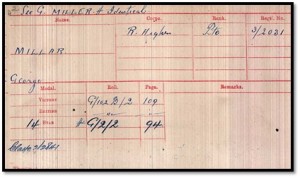
Pte George Millar was awarded the British, and Victory medals, also the 14 Star and clasp, his family would have received the Plaque “Dead man’s Penny” and scroll from King George V.
George Millar was born 1893, Haddington, North Berwick, son of Andrew Christie Millar occupation Assurance superintendent, and Elizabeth Robertson. Elizabeth died 10th November 1939, Ceres, Fife, aged 73. Andrew died 1st January 1940, Kelty, Fife, aged 74.
In 1911, George Millar 17, occupation miner was living with his family at 29 Bank Street, Lochgelly, Andrew C Millar 44, Assurance superintendent, Elizabeth 44, married 22 years and bearing 6 children all of whom survive, Annie 20, Printers compositor, John 14, miner, Andrina 13, school, Agnes 5, school.
West Fife Echo 17th February 1915.
Lance Corporal Millar Lochgelly, Lance Corporal Geo Millar of the 3rd Black Watch, eldest son of councilor A.C. Millar, Lochgelly, was killed in action on the 28th October at Ypres, in his 21st year. He was well known in Football circles and had signed on for the season for the Lochgelly United. He was given a trial for the Dunfermline Athletic against the Rangers when they played at East End Park, and his play was favourably commented on and a wish expressed for his being fixed up but the United’s overture spoilt the deal. He was also known as a student of the Dunfermline branch of the I.C.S. and frequently attended the lectures. His career has been early cut short, and condolences of regret sent to his parents and family on his bereavement gave ample proof of the very high esteem of which he was held in the community. The late Lance Corporal’s portrait will appear in the Dunfermline Journal on Saturday first and also in next Week’s Echo.
Dunfermline Journal 20th February 1915.
Lance Corporal Millar Lochgelly, Lance Corporal Geo Millar of the 3rd Black Watch, eldest son of councilor A.C. Millar, Lochgelly, was killed in action on the 28th October at Ypres, in his 21st year. He was well known in Football circles and had signed on for the season for the Lochgelly United. He was given a trial for the Dunfermline Athletic against the Rangers when they played at East End Park, and his play was favourably commented on and a wish expressed for his being fixed up but the United’s overture spoilt the deal. He was also known as a student of the Dunfermline branch of the I.C.S. and frequently attended the lectures. His career has been early cut short, and condolences of regret sent to his parents and family on his bereavement gave ample proof of the very high esteem of which he was held in the community. The late Lance Corporal’s portrait will appear in the Dunfermline Journal on Saturday first and also in next Week’s Echo.
West Fife Echo 24th February 1915.
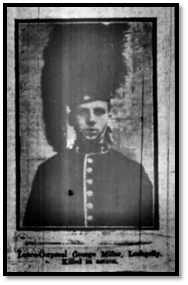
Lochgelly 1914-1818 (Facebook)
L.-Cpl. George Miller, 1st Royal Highlanders, killed in action, 28 October 1914. Ypres (Menin Gate) Memorial, West-Vlaanderen, Belgium, Panel 37.
WELL-KNOWN LOCHGELLY FOOTBALLER KILLED. News has just been received that Lance-Corporal Geo. Millar [sic], Black Watch, a son of Councillor A. C. Millar, Lochgelly, was killed in action on 29th [sic] October at the fighting on the Ypres. Lance-Corporal Millar, who was only 21 years of age, was practically among the first to go to the front and take part in the Aisne battle. He was an enthusiastic football player, and was a member of Lochgelly United. He was signed on for this year again, but had to leave before the season opened. Recently Councillor Millar received a letter in which his son said that he was in good health and spirits, and that the only thing he was missing was his game of football on a Saturday afternoon, but he was pleased to see that Lochgelly was still in the Qualifying ties. The Courier, 13 November 1914.
Dundee Courier 13th November 1914.
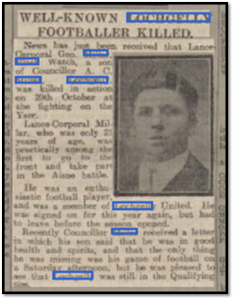
UK Registers of Soldiers Effects.
Pte George Millar 3/2031, 1st Royal Highlanders, Father Andrew received £2/10/9. Brothers John, Sisters Annie, Margaret, Andrina received £0/8/6. on 13th March 1915. Father received £3/0/0. on 1st July 1919.
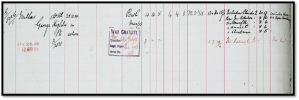
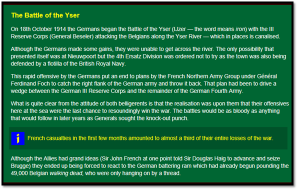
John Miller
No link found to Lochgelly, any help appreciated.
Henry Miller
Private Henry Miller, S/8950, 9th (Service) Battalion Black Watch (Royal Highlanders) Born Edinburgh, Midlothian, Enlisted Lochgelly, Fife, Residence Lochgelly, Killed in action 29th October 1916, Grave reference Pier and Face 10.A. Thiepval, Memorial, Somme, France.

CWGC
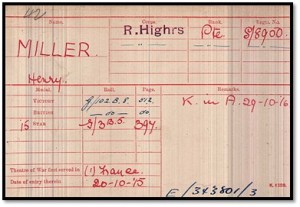
Private Henry Miller was awarded the British, and Victory medals, also the 15 Star. his family would have received the Plaque “Dead man’s Penny” and scroll from King George V.
Posted to France 20th October 1915.
Henry Miller was born 28th April 1891, Canongate, Edinburgh, the oldest of 16 children born to John Miller occupation Miner, and Mary Ferguson. Mary died 1957 Lochgelly, John died 1953, Lochgelly.
In 1911, Henry Miller 19, occupation miner was living with his family at 178 Alexander Terrace, Lochgelly, family were, father John 41, occupation miner, Mary 38, married 20 years and bearing 12 children of whom 9 survive, Peter 18, miner, Isabella 15, Helen 10, school, Louise 6, school, John 4, Thomas 3, Alex 1.
On the 5th March 1915 Henry Miller 23, occupation miner, Glencraig, Fife, married Helena Fowler 23, Glencraig, Fife.
UK Registers of Soldiers Effects.
Pte Henry Miller S/8950, 9th Royal Highlanders, widow Lena received £5/6/1. on 23rd March 1917 and £6/0/0 on 11th Oct 1919.
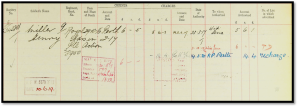
Family Headstone.
In memory of my dear husband JOHN MILLER who died 2nd April 1963 aged 82 years; HENRY eldest son killed in action, France 29th October 1916 aged 23 years; PETER died 26th December 1934 aged 42 years; JOHN killed in action, Burma 30 April 1945; WILLIAM died 22 January 1922 aged 3 years; MARY MILLER, grandchild died 7 July 1953; also, MARY FERGUSON wife of the above JOHN MILLER died 18 April 1957 aged 83 years
9th Battalion, The Black Watch was raised at Perth on 13 September 1914 as part of Kitchener’s Second New Army and joined 44th Brigade, 15th (Scottish) Division. More than 50% of the original volunteers came from Lanarkshire. They trained at Aldershot, Liss, Chisledon, and commenced final training at Tidworth in May 1915. They proceeded to France landing at Boulogne on 8 July 1915.
They were in action in the Battle of Loos in 1915. In spring 1916, they were involved in the German gas attacks near Hulluch and the defence of the Kink position. They were in action during the Battles of the Somme, including the Battle of Pozieres, the Battle of Flers-Courcelette and the capture of Martinpuich, the Battle of Le Transloy and the attacks on the Butte de Warlencourt.
Henry Miller was killed at the Battle of Transloy ( Battle of the Somme)
Thomas Milne.
Private Thomas Milne, 291007, 7th (Fife) Battalion (Territorial) Black Watch (Royal Highlanders) Previously 3308, Born Auchterderran, Fife, Enlisted Lochgelly, Residence Lochgelly, Killed in action 18th September 1917, Grave reference Panel 94 to 96. Tyne Cot Memorial, West-Vlaanderen, Belgium.
 CWGC
CWGC
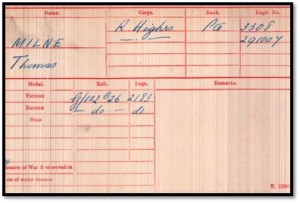
Private Thomas Milne was awarded the British, and Victory medals, his family would have received the Plaque “Dead man’s Penny” and scroll from King George V.
Thomas Milne was born 5th November 1881, Auchterderran, Fife, the eighth of twelve children born to John Milne occupation colliery labourer, and Janet Nicol. Janet died 21st September 1922, Lochgelly, John died 16th April 1914, Lochgelly.
Thomas Milne 21, occupation miner, married Maggie Lowe 19, 1904, Auchterderran, Fife.
In 1911, Thomas Milne 29, occupation miner, was living with his family at 25 Grainger Square, Lochgelly, Maggie 27, married 8 years and bearing 3 children of whom 3 survive, Agnes 7, school, John 5, Janet 3.
Dundee Evening Telegraph 2nd October 1917.
Private Thomas Milne, Lochgelly, Black Watch, killed in action, leaves a widow and five children. He enlisted early in the war and was a miner.
UK Registers of Soldiers Effects.
Pte Thomas Milne 291007, 7th Royal Highlanders, widow Margaret received £5/3/4. on 20th Feb 1918, and £12/10/0. on 20th Nov 1920.

War Diary 7th Battalion Black Watch.
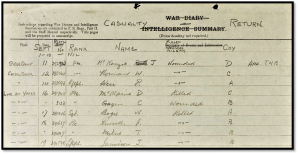
From July to November 1917 the 7th Battalion Black Watch were involved in the 3rd Battle of Ypres / Passchendaele.
Thomas Milne.
Private Thomas Adam Dow Milne, S/3205, 8th (Service) Battalion Black Watch (Royal Highlanders) Born Borthwick, Midlothian, Enlisted Bowhill, Fife, Residence Lochgelly, Fife, Killed in action 13th July 1916, Grave reference X1V.G.23. Caterpillar Valley Cemetery Longaeval, Somme, France.
 CWGC.
CWGC.
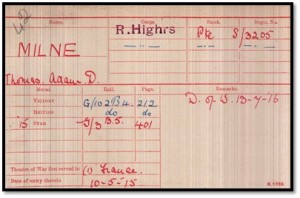
Private Thomas Adam Dow Milne was awarded the British, and Victory medals, also the 15 Star. his family would have received the Plaque “Dead man’s Penny” and scroll from King George V.
Posted to France 10th May 1915.
Thomas Adam Dow Milne was born 1894, Stobhill, Midlothian, one of ten children born to Alexander Milne and Janet Wilson, Janet died 1943, Auchterderran, Fife, Alexander died 1930, Auchterderran.
By 1911 Thomas 17, occupation miner, was living with his family at 71 Back Row, Auchterderran, Alexander 45, occupation retired miner, Janet 41, married 23 years and bearing 10 children of whom 7 survive, Lizzie 20, James 21, miner, Robert 14, William 12, school, David 7, school.
Fife Free Press 5th August 1916.
Mr and Mrs Milne, Back Row, Cardenden, have been informed that their son Private Thomas Milne, Black Watch, was killed in action on the 15th July by a gun shot wound throw the head. Prior to enlisting he was employed at Lowhill Colliery. Deceased was 22 years of age. His brother Private Robert Milne who is only 18 years of age is serving with the Argyle and Sutherland Highlanders.
UK Registers of Soldiers Effects.
Pte Thomas Adam Milne S/3205, 8th Royal Highlanders, Father Alexander received £3/15/1. on 4th Dec 1916, and £8/10/0. on 15th Oct 1919.

The 8th Black Watch Delville Wood.
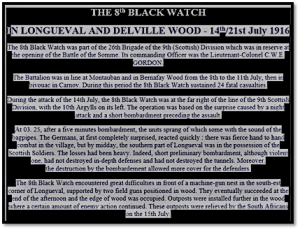
John Mitchell.
Sgt John Mitchell, Seaforth Highlanders, formerly Gordon Highlanders, is also commemorated on the Cowdenbeath War Memorial, please refer to
https://cowdenbeathwarmemorial.wordpress.com/
John Mitchell
Private John Mitchell, S/14120, 10th Battalion Princess Louise’s (Argyll and Sutherland Highlanders) Born Auchterderran, Fife, Enlisted Edinburgh, Midlothian, Residence Lochgelly, Fife, Killed in action 6th January 1917, Grave reference 11. B.11. Faubourg D’Amiens Cemetery. Arras, Pas de Calais, France.

CWGC
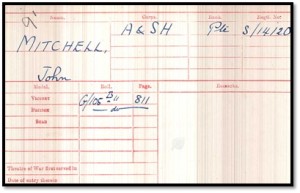
Private John Mitchell was awarded the British, and Victory medals, his family would have received the Plaque “Dead man’s Penny” and scroll from King George V.
John Mitchell was born 1894 Auchterderran, Fife, son of John Mitchell occupation Co Op Manager, and Maggie Moyes, John snr died 1949 aged 85.
In 1911, John Mitchell 16, occupation law clerk was living with his family at 93 Station Road, Lochgelly, family were, John Mitchell 46, occupation General Manager Co Op, Maggie 47, married 17 years and bearing 5 children of which 5 survive, Lizzie 14, Janet 12, school, David 10, school, Maggie 5.
On the 5th November 1915, John 20, occupation colliery clerk married Bethia Wright 18, occupation mothers help at the Manse, Lochgelly.
Dundee Courier 16th January 1917.
News has been received that Private Jack Mitchell, A & S Highlanders, a Lochgelly Man, has been killed in action. Pte Mitchell who is the son of Mr John Mitchell, manager of Lochgelly Co Operative Society, enlisted in November 1915. He was employed in the office of Lochgelly Iron and Coal Company, and was well known in the district. He was an enthusiastic member of the Y.M.C.A. and bible class.
Scotsman 17th January 1917.
Mitchell, killed in action on the 6th January 1917, Private J Mitchell, A.S. Highlanders, aged 22, son of Mr J Mitchell, manager of the Co-Operative Society, Lochgelly.
West Fife Echo 17th January 1917.
Private Jack Mitchell, A & S Highlanders, has been killed in action he was the son of Mr John Mitchell, manager of Lochgelly Co Operative Society, enlisted in November 1915. He enlisted in 1915 and had seen a lot of action.
Dunfermline Press 17th January 1917.
News has been received that Private Jack Mitchell, A & S Highlanders, a Lochgelly Man, has been killed in action. Pte Mitchell who is the son of Mr John Mitchell, manager of Lochgelly Co Operative Society, enlisted in November 1915. He was employed in the office of Lochgelly Iron and Coal Company, and was well known in the district. He was an enthusiastic member of the Y.M.C.A. and bible class.
Dunfermline High School roll of honour.

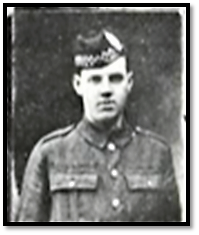
War Diary 10th Battalion A&S Highlanders.
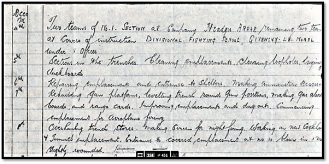
Repairing emplacement making ammunition recess.
David Mollison.
Private David Mollison, 6884, 1st Battalion Queens Own Cameron Highlanders, Born Ballingry, Fife, Enlisted Lochgelly, Residence Lochgelly, Killed in action 14th September 1914, Grave reference La Ferte-Sous-Jouarre Memorial, Seine-et-Marne, France.
 CWGC.
CWGC.
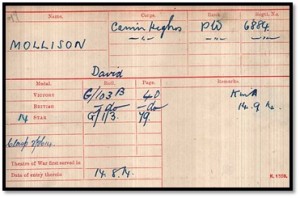
Private David Mollison was awarded the British, and Victory medals, also the 14 Star and clasp, his family would have received the Plaque “Dead man’s Penny” and scroll from King George V.
Posted to France 14th August 1914.
David West Mollison was born 1883, in Ballingry, Fife, son of James Mollison occupation Blacksmith, and Margaret West. Margaret died 1914 aged 69, James died 1927, Lumphinnans aged 78.
David West Mollison 26, occupation miner married Euphemia Mclean Golden 28, at South Street, Lochgelly.
In 1911, David 27, occupation miner, was living with his family at 4 Parkview Place, Lochgelly, Euphemia 30, married 1 year and bearing 1 child, James 6m.
Dundee Courier 26th July 1915.
Mollison: – Private David 6884, 1st Cameron Highlanders, B Coy. Officially reported missing since 14th September 1914. His anxious wife inquires. Mrs David Mollison, 28 Parkview Place, Lochgelly. This advert also appeared in the Dundee Courier 28th and 29th July.
UK Registers of Soldiers Effects.
Pte David Mollison 6884, 1st Cameron Highlanders, widow Euphemia received £4/16/2. on 23rd March 1916, and £5/0/0. on 31st July 1919.
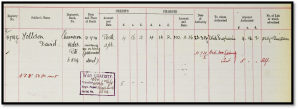
1st Battalion Queens Own Cameron Highlanders War Diary.
On 14 September the Battalion marched off from north of Paissy at 5:45, and moved due west of Vendresse to take their position on the line. With them moved the 1st Coldstream Guards, 1st Black Watch, 1st Scots Guards. En route, the Battalion came under long range rifle fire. The diary says that A Coy were deployed on a line across the Troyon, with B coy on their left. It was added that an attack by the Germans from the left flank across the wooded valley, and a portion of B Coy was put in the rear to guard the left flank. A Coy followed by D advanced on a factory to the north of Troyon. But, before they reached it, they came under very heavy fire from shrapnel and high explosive shells. The Germans were now sighted on the ridge due north of Chivy. The diary goes on to add that there was a certain amount of confusion caused by a party of German prisoners being escorted through the wood on the immediate left. The battle originally began at 7am. At about 7:20am, the German attack from the Camerons left front about Le Blanc Mont began to develop seriously. B Company was ordered to advance. The whole front was heavily attacked. A company of Black Watch came up to the Camerons left. At 8:50am, a portion of the right gave ground and took cover under the road bank at Chivy-Chemin wood. The majority of the Camerons retained their positions in good order from the factory. Battalions were reorganised in units in the Chivy-Chemin wood and taken forward onto the crest just north east of that point of the wood when a heavy fire was opened on the Germans north of Le Blanc Mont, apparently with considerable success. A certain number of casualties were caused by the Battalion rifle fire from the rear, though every effort was made to stop it. About 10 minutes later the Germans then attacked with ‘renewed vigour and in greatly superior numbers all along the front.’ The Machine Gun Section came into action due north of the point of the wood. All units were mixed here and the fire was very heavy from rifle, machine guns, shrapnel and high explosive shells. It was added that there were ‘a great many casualties’.
Ominously the diary further states that C Company on the left had 13 men killed altogether. This was due to the fact that a body of Germans advanced waving their rifles above their heads and apparently wishing to surrender. On the platoon going forward they were ‘decimated by the fire of another German line behind, and the line apparently wishing to surrender lay down and probably fired also’. At about 11:30 the right flank got badly hit from the direction of Troyon. A Company and part of D ran out of ammunition and they moved back into the wood which was being heavily shelled. By this stage, the Brigade fell back and the Battalion got considerably split up, but order was maintained as far as possible. There were further casualties from shell fire, and by the evening the Battalion was entrenched on the north east edge of the Vendresse Valley.
On 14 September, as a result of a German counter attack around Chivy and Beaulne on the 1st and 2nd Guards Brigade, the 1st Cameron Highlanders flank became exposed after the Germans captured a sugar factory. Machine gun fire caused many casualties. The 1st Cameron Highlanders had been forming up for a counter attack under the cover of a wood in the Chivy Valley which runs a little to the west of Troyon. At 7am, the advance began. Having come out of the trees, the Battalion was subjected to rifle and artillery fire as well.
One Company to the right was shattered straight away, but the rest maintained their advance. They were supported by elements of the 1st Black Watch and 1st Scots Guards. They managed to storm the German trenches on the plateau above them. It was mentioned as a ‘tremendous sight as Highlanders swept through the German trenches and took up firing line eighty yards beyond the road’.
With two and a half companies across the road the remainder of the Cameron Highlanders moved up a smaller ridge where they brought fire on the Chemin Des Dames ridge. The Battalion now occupied an S shaped firing line which at 8.00am was attacked along its whole length. The power of German infantry forced the right flank to fall back behind. But they attacked on the flank and had by then lost more than half their force and were low on ammunition. This resulted in them moving back down the Chivy Valley and ended up at their start line, with less than 50 men under the command of a Major Hon A H Maitland who clung to the ground until all their ammunition was almost exhausted. They had to fall back 50 yards behind the crest of the ridge where they were finally overwhelmed by massed attacks which resulted in Major Maitland being killed. Also, during the battle, Private Ross Tollerton of the 1st Camerons was awarded the VC for his actions in bringing in a wounded officer.
German counter-attacks were in place within hours however, forcing the Allies back. The German army had demonstrated the effectiveness of defensive warfare. Small advances were achieved, but these could not be consolidated. The 1st Camerons were relieved on 19 September and went into Reserve and billeted. They were back at the front by the 23rd. Fighting was abandoned on 28 September once it finally became clear that neither side would be able to mount frontal attacks upon the well entrenched positions of the enemy. Commander Sir John French ordering the BEF to dig trenches. As the BEF were not prepared for this, they had to look for digging tools in nearby farms. Initially, only shallow pits were dug up, but were replaced later by trenches of 7ft.
The 1st Division Casualties from the fighting on 14 September alone came to 3,500 officers and men. Many of these were from the two Highland regiments with 600 officers and men of the Cameron Highlanders lost this day. The Commonwealth War Graves Commission have 144 men of the 1st Cameron Highlanders listed as dying on 14 September 1914 – they are buried in a number of cemeteries on the Aisne, or are named on the Memorial to the Missing at La Ferte-Sous-Jouarre. Further to their casualties on 14 September the Camerons suffered another major setback on 25 September, while still on the Aisne. A shell caused the collapse of the cave being used as the battalion HQ, killing five officers and about 30 men.
On 20 September, Sir John French, Chief of Staff of the British Army, had told the Brigadier that the ‘action had been most important and highly commended the conduct of the Brigade’. He stated though ‘he deplored the heavy casualties, it was absolutely necessary’ in order to defend the Aisne, which had been successfully done. By the end of 1915, he was replaced by Douglas Haig.
William More
Private William More, 16395, 12th Battalion Royal Scots (Lothian Regiment) Born Cambeck, Fife, Enlisted Cowdenbeath, Residence Lochgelly, Killed in action 14th July 1916, Grave reference II.C.10. Quarry Cemetery Montauban, Somme, France.
 CWGC
CWGC

Private William More was awarded the British, and Victory medal, also the 15 Star. his family would have received the Plaque “Dead man’s Penny” and scroll from King George V.
Posted to France 21st April 1914.
William More was born 29th November 1878, Kemback, Fife, oldest son of James More occupation Mill Labourer, and Rose Ann Higgins, James died 1932, Cupar, aged 79, Rose died 1925, Cupar.
In 1901, William Moore 22, occupation miner, was living as a boarder at 89 Union Street, Cowdenbeath.
On the 4th October 1901, William More 22, occupation miner married Margaret Morris 18, in Beath, Fife.
By 1911, William 32, occupation miner was living with his family at 8 Livingstone Place, Lochgelly with his family, Margaret married 9 years and bearing 6 children of which 4 survive, Christina 8, school, Margaret 6, school, Cecila 3, Helen. (Williamina More was born 17th February 1914, at 1 Kinnard Street, Lochgelly) Margaret Morris More married William Yorkston 1927, Lochgelly, Christina married George McLean 1921, Lochgelly, Cecila Porter More married Thomas Short Sturrock 1929, Lochgelly, Helen Morris More married Robert Gibson 1933, Lochgelly.
Fife Free Press & Kirkcaldy Guardian 26th August 1916.
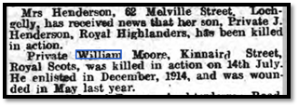
Same article in Dundee Evening Telegraph 16th August 1916.
UK Registers of Soldiers Effects.
Pte William More 16395, 12th Royal Scots, widow Margaret received £3/5/6. on 7th Nov 1916, and £7.0.0 on 22nd Sept 1919.

THE BATTLE OF THE SOMME.
By the summer of 1916 the British Army in France had grown to some fifty-eight divisions, in all some 1.5 million men. Haig, who had taken over as Commander-in-Chief from Sir John French in December 1915, now had the manpower that he had lacked earlier and, at 7.30 am on 1 July, eleven divisions, nine of them New Army divisions, advanced simultaneously against the German positions on the north bank of the Somme. By nightfall British losses were over 57,000, of whom nearly 20,000 were dead. Some gains were made by the attacking forces on the right (southern) flank, but elsewhere the attack had stopped in its tracks. The first day of the Somme, in terms of casualties, remains the blackest day in the history of the British Army.
The 11th and 12th Battalions, having moved to the area of Albert in June, were initially hard at work carrying stores of all natures to dumps near the front, but did not participate in the initial assault. On the night of 2 July, they moved forward to positions in Montauban. At 9 pm on 3 July the 12th Battalion mounted an attack on Bernafay Wood and, unexpectedly, the Germans withdrew, leaving behind four field guns and one machine gun. Despite that auspicious start, Bernafay Wood proved an unwelcome gain. Regular shelling resulted in numerous casualties. The 12th manned its positions there until 8 July when, together with the 11th Battalion, it was relieved and both battalions marched to the rear for some much-needed rest, re-equipment and re-organisation.
The next major action for both Battalions was the attempt to take Longueval and the adjacent Delville Wood. These two features were situated on the crest of the plateau and were key positions. If the British could force the Germans out of their well-prepared defences the prospects for being able to continue the advance were good. Inevitably, however, the Germans were equally aware of their significance. The attack began on 14 July. The 11th, together with the 9th Scottish Rifles (Cameroonian’s), were to capture the German trenches in front of Longueval and, thereafter, both Royal Scots Battalions were to seize the village. The operation began with a wholly successful night approach march during which the attackers moved silently into positions some 300 to 500 yards from the German front line. Sadly, however, the Commanding Officer of the 12th Battalion was killed in random shellfire during the move. Our artillery bombardment started at 3.30 am and five minutes later the infantry advanced. The 11th Battalion encountered wire entanglements before it reached the first German trench. During the inevitable delay, while the wire was cut by hand, casualties were heavy. Once the first trench had been secured the Battalion had little difficulty in taking the remaining German trenches forward of the village and its initial objective was secured within the hour. The 12th Battalion, following in support of the 11th, had closed up on it at the German wire. It had also sustained severe casualties and, as a consequence, B Company of the 12th was led into the attack by Private Roden who was awarded the MM for his actions.
At 4.15 am the artillery bombardment lifted from the village and both Battalions continued their advance. It immediately became clear, however that the enemy had no intention of giving up its hold on the village. The 11th, on the left flank, was able to advance to positions on the western edge of the village where it dug in to await the 12th coming up on its right. The latter’s advance met stiff opposition but, despite losing nearly half of its fighting strength, by 7 am it had fought its way forward to occupy a shallow trench just south-west of the centre of the village. After a brief pause a further attempt to advance was made but it was again halted, 50 yards from the centre of the village, by murderous defensive fire, forcing the attackers to dig in. The 12th made two further attempts that day to secure the village bur with no more success. Reluctantly it was acknowledged that, in the short term, further progress was impossible and the Battalion spent the remainder of the day consolidating its position. The following day, the 15th, two further assaults were mounted but the gains that were made were short-lived as, in each case, the attackers were eventually forced back to their start points. The 12th Battalion was unable to make further progress but, equally, it had no intention of relinquishing its lodgement in the village and a German counter-attack, mounted late in the evening, was quickly broken up.
Thomas Morgan.
Able Seaman Thomas Morgan, Z/3069, Anson Battalion Royal Naval Division, Royal Naval Volunteer Reserve, Born Slamman, Stirlingshire, Residence Lochgelly, Fife, Died 16th August 1915, Grave reference II.H.22. Beach Cemetery Anzac. Turkey, (Including Gallipoli)
 CWGC
CWGC

A.B. Thomas Morgan was awarded the British, and Victory medal, also the 15 Star. his family would have received the Plaque “Dead man’s Penny” and scroll from King George V.
Thomas Brown Morgan was born 31st December 1897, son of William Morgan occupation miner, and Agnes Brown. Agnes died 1928, Lumphinnans, aged 59. William died 1915, Lochgelly.
By 1911, Thomas 14, was living with his family at 4 Melville Street, Lochgelly, William 50, occupation miner, Agnes Brown 40, married 17 years and bearing 9 children of which 8 survive, Agnes 17, linen weaver, Annie 12, school, Marion 10, school.
Service details.
Able Seaman Thomas Morgan, Anson Battalion, Royal Naval Volunteer Reserve, enlisted 12th January 1915, (probably Lochgelly) Born 31st December 1896. A Miner. Resided with father, William, at 7a Hall St., Lochgelly, Fife. drafted to Mediterranean Expeditionary Force 28th June 1915, joined 3rd Platoon Anson 18th July 1915. Date of death 16th August 1915, died of wounds in 2nd (RN) Field Ambulance at Anzac (Shrapnel wound in back same date)
West Fife Echo 15th September 1915.
Able seaman Thomas Morgan, Hall Street, Lochgelly, has died of wounds received at Gallipoli. He was 19 years of age and was serving in the Anson Battalion of the Royal Naval Division.
Dundee Courier 14th September 1915.
Mr Wm Morgan, Hall Street, Lochgelly, has received intimation that his son Able seaman Thomas Morgan R.N.V.R. has died of wounds received at Gallipoli. Deceased was only 19 years of age, and was serving in the Anson battalion of the Royal Naval division.
Fife Free Press 18th September 1915.
Lochgelly man killed at Dardanelles, Able seaman Thomas Morgan, Hall Street, Lochgelly, das died from wounds received at Gallipoli, he was 19 years of age, and was serving in the Anson battalion of the Royal Naval division. (Same article in Dunfermline Press)
The division was shipped to Egypt prior to serving in the Battle of Gallipoli. Casualties before the hostilities included officer and poet, Rupert Brooke, who died at sea on 23 April 1915. The division fought on both the Anzac and Helles battlefields.
The RND was one of two British divisions (the other being the Regular Army 29th Division) at the Gallipoli landings. Originally the division was only required to make a diversion at Bulair in support of the main landings at Anzac Cove and Cape Helles. This diversion was carried out by one man, Bernard Freyberg. Shortly afterwards, on 28 April, four battalions were sent to Anzac to reinforce the hard-pressed Australian and New Zealand troops. Later the RND moved to Helles where it remained for the rest of the campaign on the peninsula.
David Morgan.
Lance Sergeant David Morgan, 6600, 1st Battalion Northumberland Fusiliers, Born Consett, Durham, Enlisted Hamilton Lanarkshire, Residence Lochgelly, Fife, Killed in action 26th September 1917, Grave reference Panel 19 to 23 and 162, Tyne Cot Memorial, West-Vlaanderen, Belgium.
 CWGC
CWGC
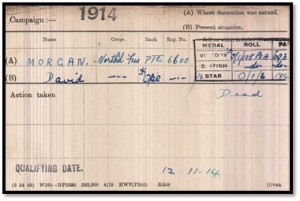
L/Sergeant David Morgan was awarded the British, and Victory medals, also the 14 Star. his family would have received the Plaque “Dead man’s Penny” and scroll from King George V.
Posted to France 12th November 1914.
David Morgan was born about 1883, Concett, Durham, son of David Morgan and Mary Mainland Cross, Mary died 1891, in Durham, father David died 1901, Durham.
In 1911, David 27, occupation miner, was living at 10 Russell Street, Lochgelly, as a boarder with Robert Muircroft 31, miner, David Hay 17, miner, Annie 3.
Dunfermline Press 3rd November 1917.
Lochgelly, Sergeant David Morgan, Northumberland Fusiliers, who had 17 years’ service, has been killed in action. A brother Private Henry Morgan, New Zealand Forces, has also met his death at the front. (Brother Henry known as Harry Cross Morgan was killed 10 October 1917)
UK Registers of Soldiers Effects.
L/Sgt David Morgan 6600, 1st Batt Northumberland Fusiliers, Brother John received £22/14/4. on 2nd April 1918, and £19/0/0 on 15th Nov 1919.

The Battle of Polygon Wood was the fifth major battle by the British Army during the Third Battle of Ypres, later known as Passchendaele. It was a highly significant battle.
Polygon Wood was a significant landmark in the Ypres Salient battlefields. It had been fought over throughout the war and the trees had been all but destroyed by shellfire. The Germans recognised its importance and in 1916/1917 fortified the wood with multiple concrete block houses and thick tangles of barbed wire.
The Battle of Polygon Wood began at 5.50am on 26 September. Seven divisions took part, including the 4th and 5th Australian Divisions, who attacked the German lines from just south of the village of Zonnebeke to Polygon Wood.
At the centre of Polygon Wood was a dominating mound called the ‘Butte’. Built by the Belgian military as a firing range before the war, it had been fortified by the Germans and was used as an observation post. Resistance was heavy but Australian soldiers took the Butte and had successfully secured the wood by the end of the day. Fighting continued until 3 October, with German forces launching numerous unsuccessful counter-attacks.
An important factor in the success was the clear weather which allowed the Royal Flying Corps to provide support. British fighter aircraft fought with their German counterparts above no-man’s land, providing cover for observation aircraft to direct artillery and support soldiers on the ground.
Although the Battle of Polygon Wood is regarded as a victory for the British Army, its forces suffered more than 20,000 casualties, killed and wounded. German losses are contested, with estimates being some 13,500 casualties.
Robert Morton.
Private Robert Morton, S/9989, 1st/5th Battalion Princess Louise’s (Argyll and Sutherland Highlanders) Born Falkirk, Stirlingshire, Enlisted Edinburgh, Midlothian, Residence Lochgelly, Fife, Killed in action 28th September 1918, Grave reference Panel 141 to 143 and 162, Tyne Cot Memorial, West-Vlaanderen Belgium.
 CWGC.
CWGC.
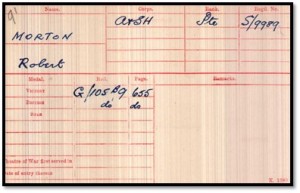
Private Robert Morton was awarded the British, and Victory medals, his family would have received the Plaque “Dead man’s Penny” and scroll from King George V.
Robert Ferguson Morton was born 1893, Falkirk, the second of nine children born to Robert Morton occupation Foundry Labourer, and Maria Brown Ferguson. Marian died 24th January 1924, Denny, Stirlingshire, aged 64. Robert Morton died 26th February 1937, Falkirk, aged 80.
In 1911, Robert 18, occupation Brass Finisher, was living with his family at 33 Firs Street, Falkirk, Robert 53, occupation Labourer, Maria 50, married 19 years and bearing nine children of which nine survive, William 23, Iron Moulder, Alex 17, Iron Moulder, Maggie 15, David 14, Effie 13, John 11, Agnes 9, Lizzie 5.
Falkirk Herald 23rd November 1918.
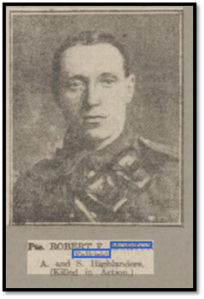
UK Registers of Soldiers Effects.
Pte Robert Morton 9989, 1/5th A&SH. Mother Maria received £30/5/5. on 6th May 1919, and £14/10/0. on 9th Dec 1919.
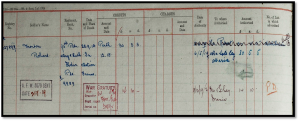
Robert Morton was killed at the 5th Battle of Ypres. 28th September 1918.
The Groupe d’Armées des Flanders (GAF, Flanders Army Group) attacked at 5:30 a.m. on 28 September, after a 3-hour artillery preparation. GAF attacked with 12 Belgian divisions, 10 British divisions of the Second Army and 6 French divisions of the Sixth Army. The British attacked on a 4.5 mi (7.2 km) front up to the Ypres–Zonnebeke road, from where the Belgian army attacked on a line north to Dixmude. The Allied attacks quickly penetrated the German defences and advanced up to 6 mi (9.7 km). Much of the ground west of Passchendaele, abandoned during the withdrawal of early 1918, was recaptured. Rain began to fall but by the evening the British had taken Kortewilde, Zandvoorde, Kruiseecke and Becelaere; Belgian troops had captured Zonnebeke, Poelcappelle, Schaap Baillie and Houthulst Forest. On the southern flank, minor operations by three British divisions advanced to St. Yves, Messines and the ridge from Wytschaete to Hollenbeck. The German front line ran from Dixmude to Houthult, Becelare, Zandvoorde and Hollenbeck.
The British suffered 4,695 casualties, the Belgians 4,500 “net” casualties from among 2,000 killed and 10,000 men ill or wounded. The Allies advanced up to 18 mi (29 km), with an average advance of 6 mi (9.7 km) and captured c. 10,000 prisoners, 300 guns and 600 machine-guns.
Thomas Mould.
Private Thomas Selcraig Thomas, 291004, 6th (Perthshire) Battalion (Territorial) Black Watch (Royal Highlanders) Born Greenside, Midlothian, Enlisted Lochgelly, Fife, Residence Lochgelly, Killed in action 21st March 1918, Grave reference Bay 6. Arras Memorial, Pas de Calais, France.
 CWGC
CWGC
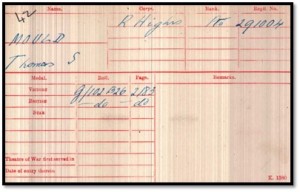
Private Thomas Mould Cook was awarded the British, and Victory medals, his family would have received the Plaque “Dead man’s Penny” and scroll from King George V.
Thomas Selcraig Mould was born 2nd October 1874, Edinburgh, Midlothian, son of Andrew Mould occupation Letterpress Printer and Mary Selcraig. Mary died 1888, Edinburgh. Andrew died 1891, Edinburgh.
Thomas Selcraig Mould 25, occupation Blacksmith married Jane Gibson White 28, Domestic Servant, 1901, Uphall, West Lothian.
In 1911, Thomas Mould 36, Blacksmith, was living with his family in Lumphinnans, Fife, Jeannie 38, married 10 years and bearing 4 children of whom all survive, James 9, school, Jeannie 8, school, Thomas 5, Robert 2.
Dundee People’s Journal 18th January 1919.
Mould, Private Thomas S Mould, No 291004, 2nd Platoon A Company 6th Battalion Black Watch, missing since 21st March 1918. Wife enquires – Mrs J Mould 106 Lumphinnans Road, Lochgelly.
UK Registers of Soldiers Effects.
Pte Thomas Selcraig Mould 291004, 1/6th Royal Highlanders, widow Jane received £21/0/10. on 5th Aug 1919.

On March 21, 1918, the German army on the Western Front unleashed a series of massive attacks on the exhausted British and French armies. German General Erich Ludendorff thought he could win World War I with one final blow. He planned to punch holes between the French and British armies. Then he would drive through their trenches to the English Channel, isolating and destroying the British army. On March 21, 1918, the German army on the Western Front unleashed a series of massive attacks on the exhausted British and French armies. German General Erich Ludendorff thought he could win World War I with one final blow. He planned to punch holes between the French and British armies. Then he would drive through their trenches to the English Channel, isolating and destroying the British army. Yet for a brief moment, the war had suddenly swung in Germany’s favor by March 1918. The German army had just knocked Russia and its new Bolshevik government out of the war. The victory on the Eastern Front freed up nearly 1 million German and Austrian soldiers, who were transferred west. Germany had refined new rolling artillery barrages. Its dreaded “Stormtroopers” had mastered dispersed advances. The result was a brief window of advantage before the American juggernaut changed the war’s arithmetic.
The Spring Offensive almost worked. Within days, the British army had suffered some 50,000 casualties. Altogether, about a half-million French, British and American troops were killed or wounded during the entire offensive.
Andrew Moyes.
Private Andrew Moyes, 202104, 8th (Service) Battalion Black Watch (Royal Highlanders) Previously 3115,6190, Born Beath, Fife, Enlisted Lochgelly, Residence Lochgelly, Killed in action 19th July 1918, Grave reference Panel 17. Ploegsteert Memorial, Hainaut, Belgium. (Also commemorated on the family headstone in Lochgelly Cemetery, Lochgelly)
 CWGC
CWGC
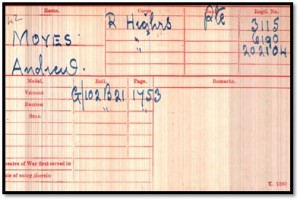
Private Andrew Moyes was awarded the British, and Victory medals, his family would have received the Plaque “Dead man’s Penny” and scroll from King George V.
Posted to France 10th March 1915.
Andrew was born 3rd January 1884, Cowdenbeath, Fife, the third of eleven children born to John Moyes, occupation coal miner, and Mary Dow. Mary died 1912, Lochgelly. John died 1937, Lochgelly.
In 1911, Andrew 27, occupation miner, was living with his family at 114 Auchterderran Road, family were, John 55, furnace stoker, Mary 56, married 36 years and bearing 11 children 10 of whom survive, Mary 25, William coachman, Jessie 16 domestic, James 13, school, Peter, school.
Dunfermline Press 17th August 1918.
Andrew Moyes, Black Watch, North Street, is reported to have been killed in action in France. He had been over three years at the front. (same article in Dunfermline Journal 24August 1918)
West Fife Echo 21st August 1918.
Private Andrew Moyes, Black Watch, North Street, Lochgelly, who has been over three years at the front in France, and was previously wounded is reported to have been killed.
UK Registers of Soldiers Effects.
Pte Andrew Moyes 20204, 8th Royal Highlanders, Father John received £6/19/1. and £17/0/0 on 13th Dec 1919.
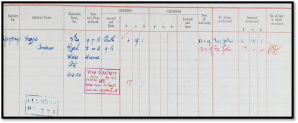
Family Headstone Lochgelly Cemetery.
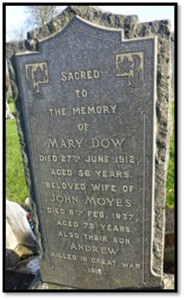
On the 19th of July 1918 the 8th B/W are in the Attack on Meteren.
A reconnaissance was made by an officer from Battalion Headquarters between 10 a.m. and 12 noon, who found that the 8th, with the exception of McDonalds force, had been held up by the hedges referred to, the wire in front of the hedges being almost intact. Attacking and supporting companies had suffered severe losses in attempting to force this line, and it was eventually found necessary to withdraw the remnants of these companies to the jumping-off post.”
Second Lieutenant McDonald had sent a message at 11.30 a.m. stating that his platoon had reached its objective on the left of the Camerons.
Robert Muir
Private Robert Muir, 202556, 4th Battalion Gordon Highlanders, formerly 6063, Born Beath, Fife, Enlisted Lochgelly, Residence Lochgelly, Killed in action 23rd April 1917. Grave reference V11. G. 18. Brown’s Copse Cemetery, Roeux, Pas de Calais, France.
 CWGC
CWGC

Private Robert Muir was awarded the British, and Victory medals, his family would have received the Plaque “Dead man’s Penny” and scroll from King George V.
Robert Muir was born 1884, Beath, Fife son of Hugh occupation miner and Margaret Scott, died 1938 Auchterderran Fife. aged 90. Hugh died 1929, Auchterderran, aged 83.
Family 1901, Hugh was a coal miner living with his wife, Margaret, and their children, James, Charles, Hugh, Violet, Andrew, Robert, Amelia, John, Catherine, Margaret, and Agnes. Living there also was Margaret’s widowed father, Charles Scott.
By 1911, Robert Muir 27, occupation Clerk (Co-Op) was living with his family in Auchterderran, father Hugh 64.
UK Registers of Soldiers Effects.
Pte Robert Muir 202556, 1/4th Gordon Highlanders, widow Annie received £2/3/8 on 4th Sept 1917, and £3/0/0 on 24th Oct 1919.

War Diary 4th Battalion Gordon Highlanders 23rd April 1917.
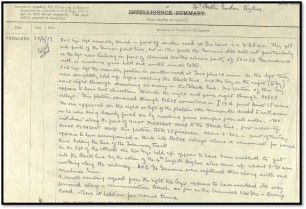
Will.
![]()
Arras Offensive, April 1917
The 8th and 10th Battalions had amalgamated in 1915 and in January 1917 carried out a successful raid dressed in white to blend in with the snow. This was at the Butte de Warlencourt. In April they were part of the Arras offensive and were pinned down by heavy fire at Railway Triangle just east of the city of Arras. Eventually they battled their way through and defeated the enemy. The 4th and 5th Battalions fought alongside each other to help capture Vimy Ridge, 5 miles north of Arras, after a determined attack by the Canadians and themselves, the 4th suffering particularly badly. The 6th Battalion also suffered heavy casualties but achieved their objective at Rolincourt.
William Mulligan.
No record found for William Mulligan, there is a Michael Mulligan in Inverkeithing, Fife, aged 20, in the 1911 census. No record found to link Mulligan with Lochgelly.